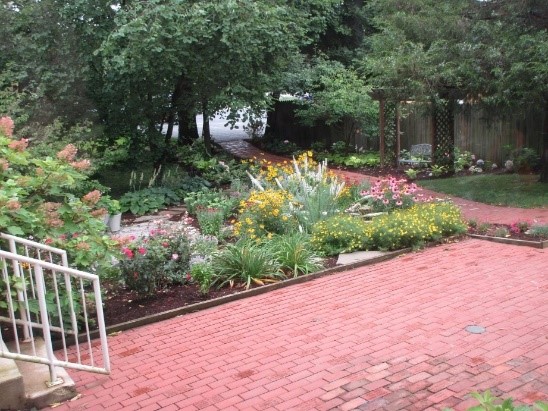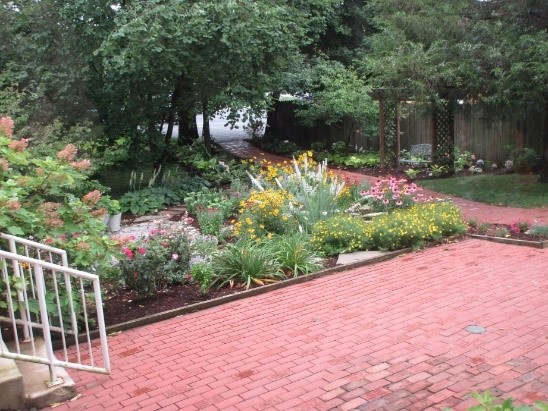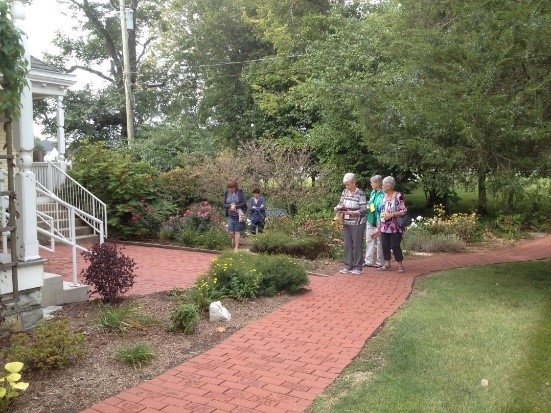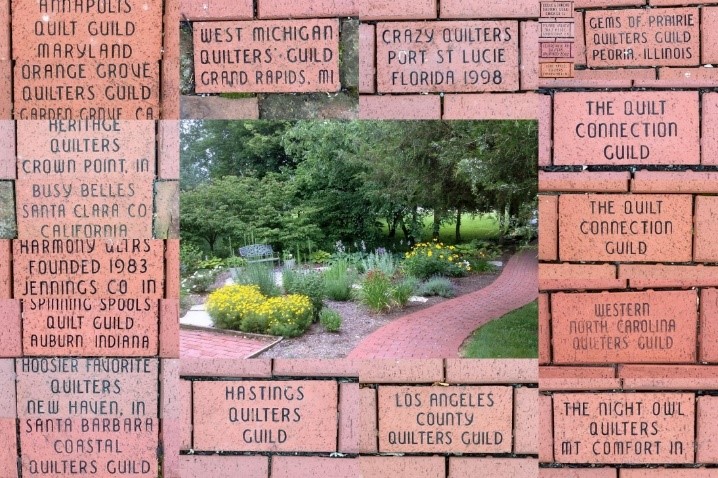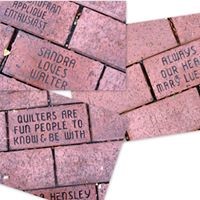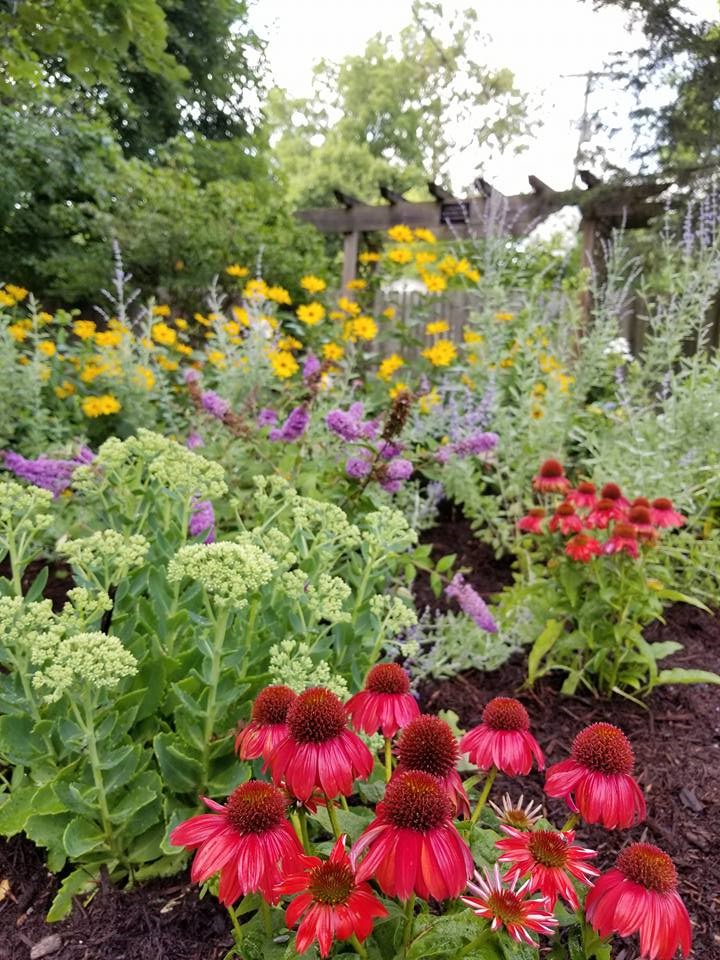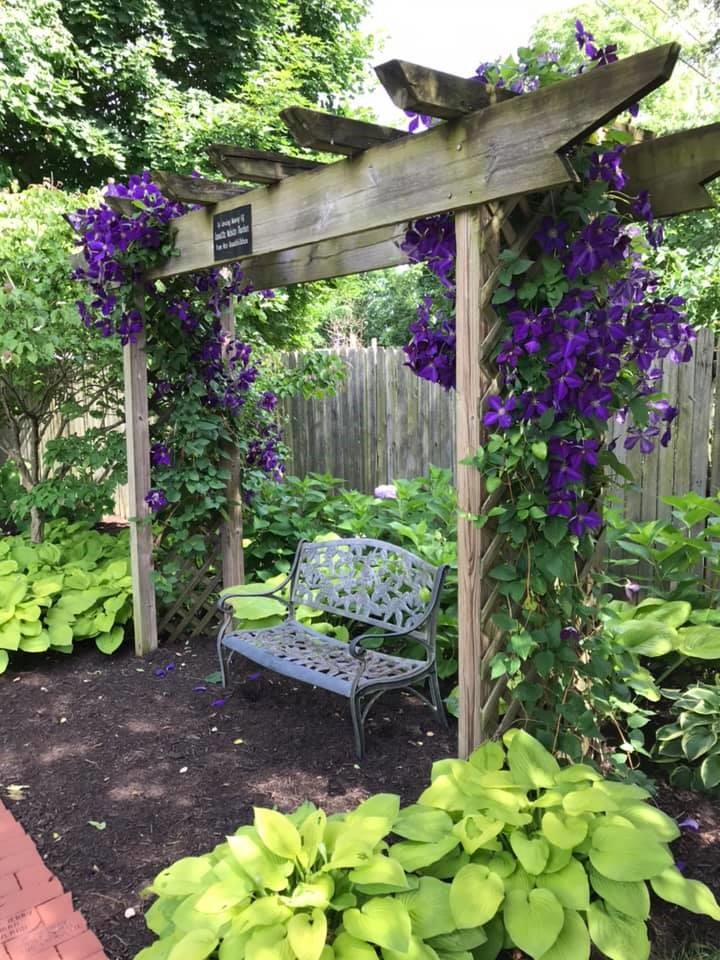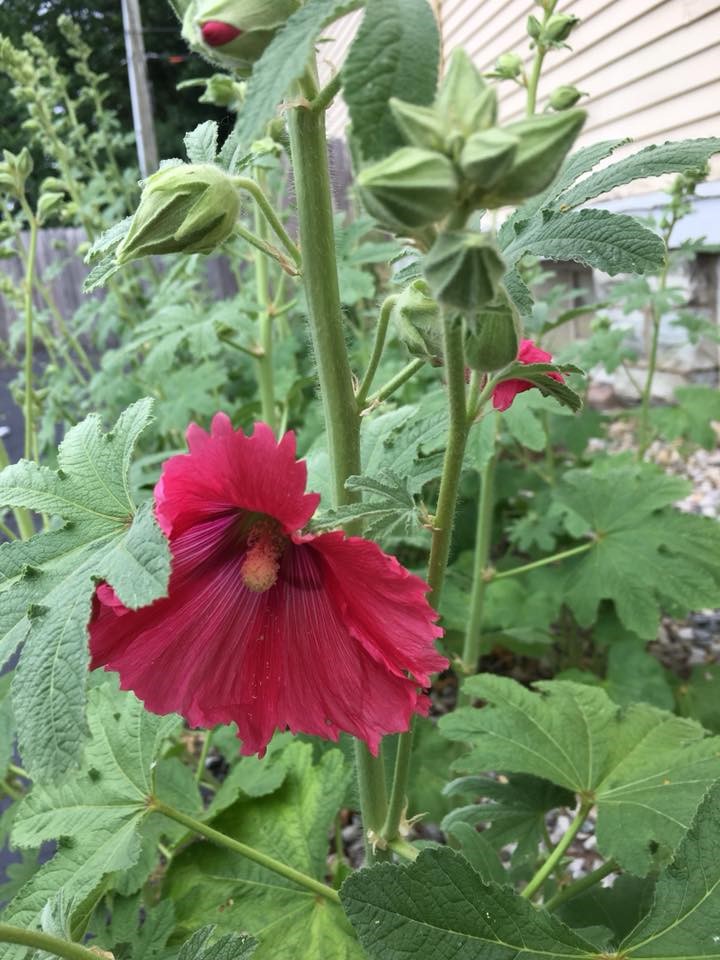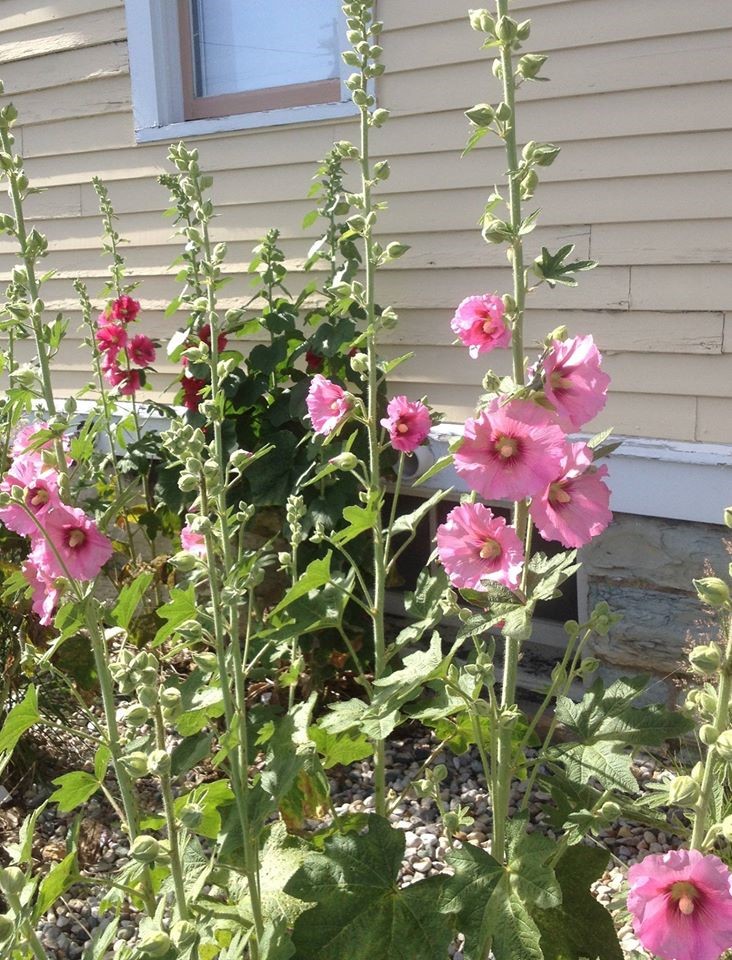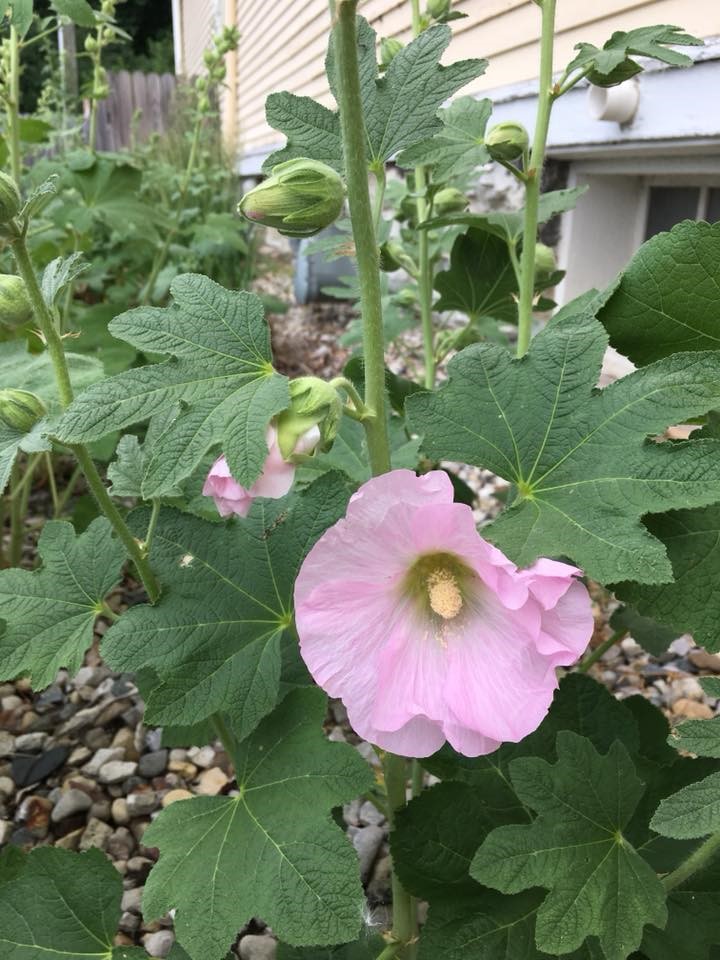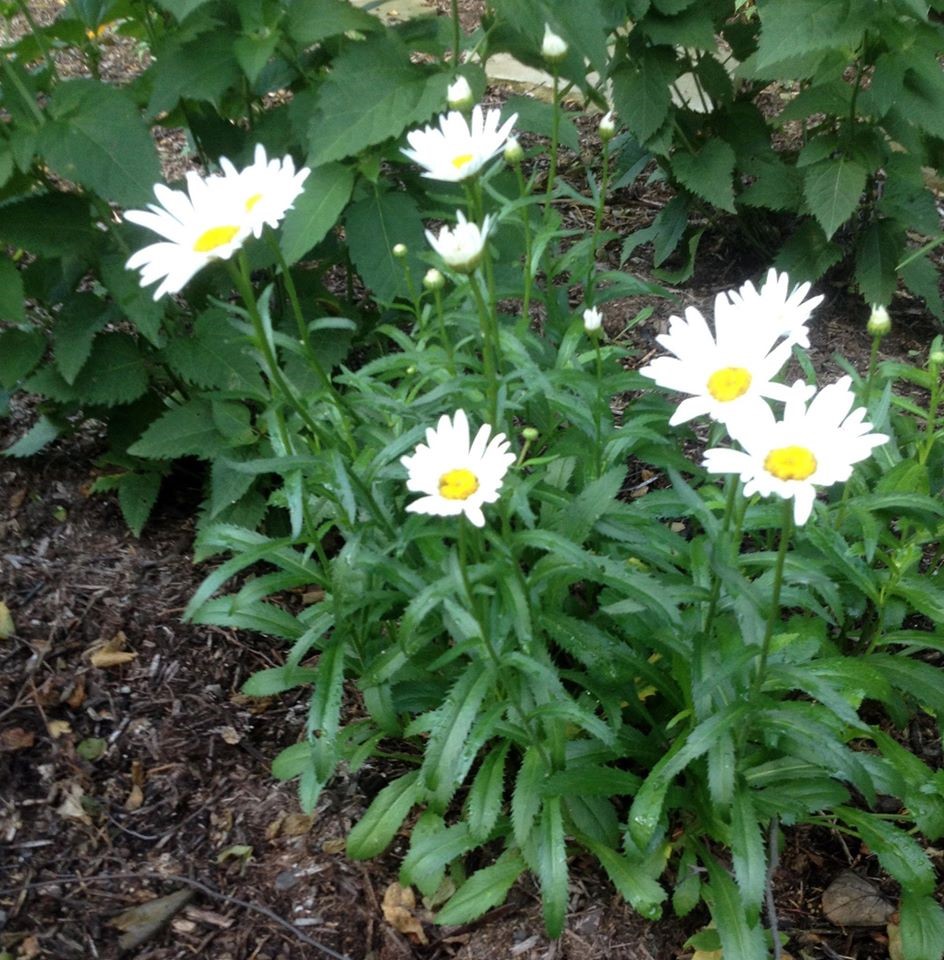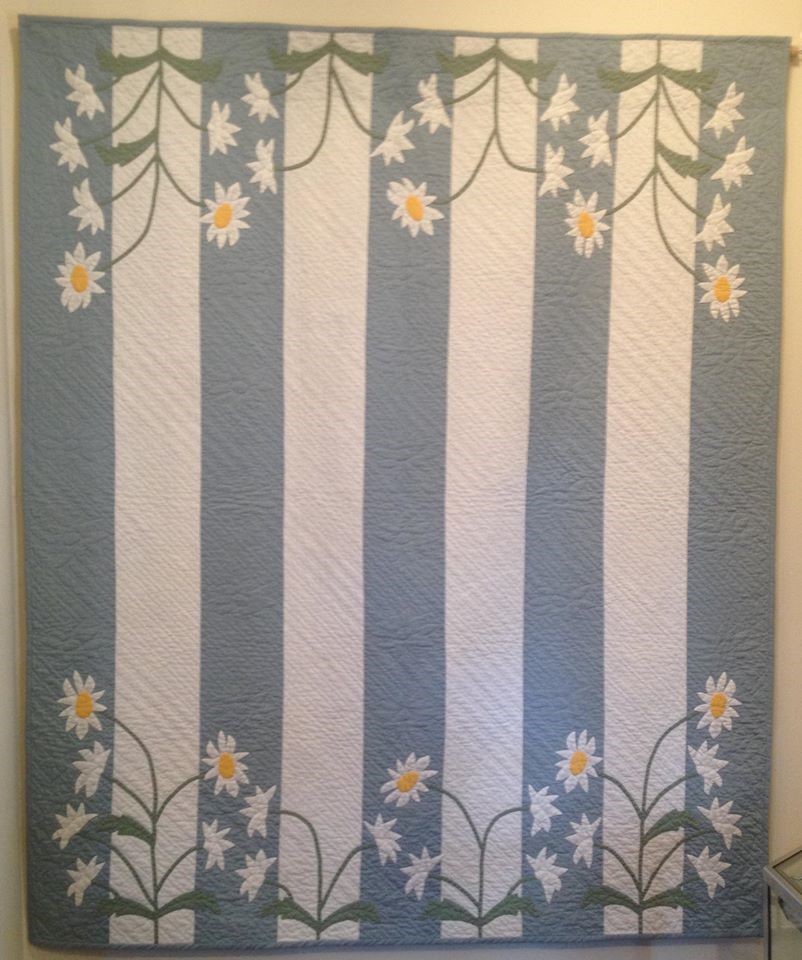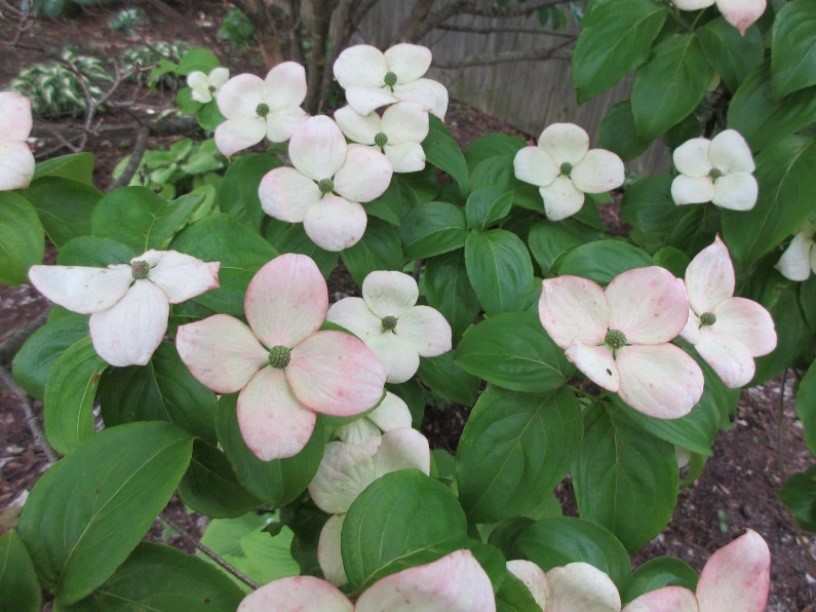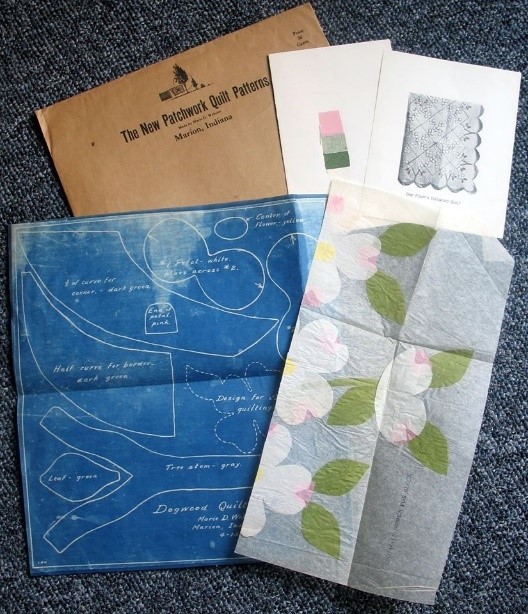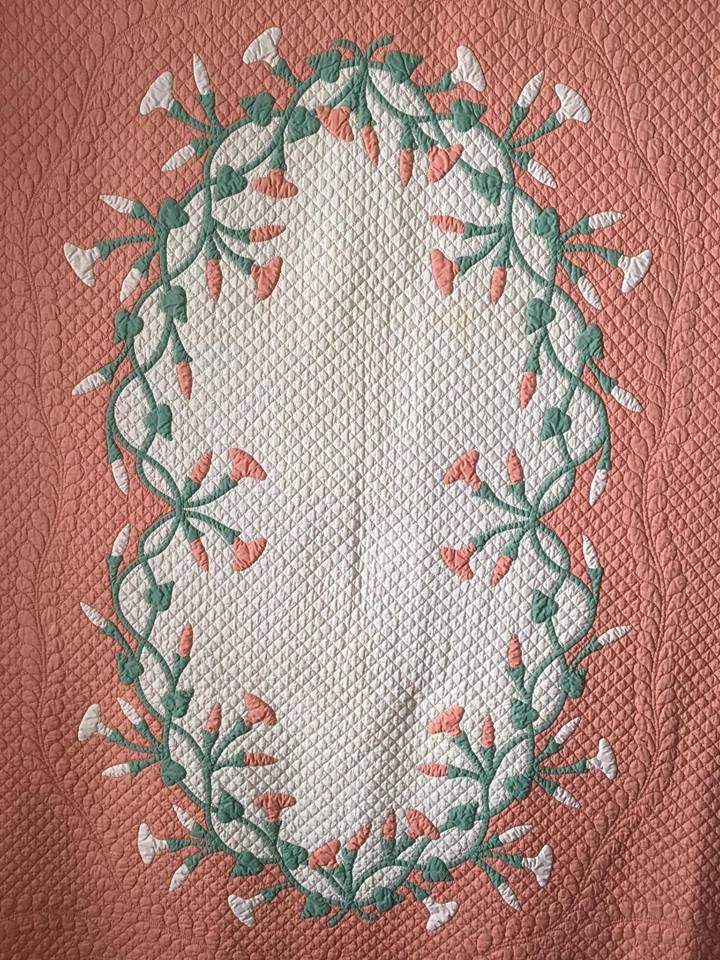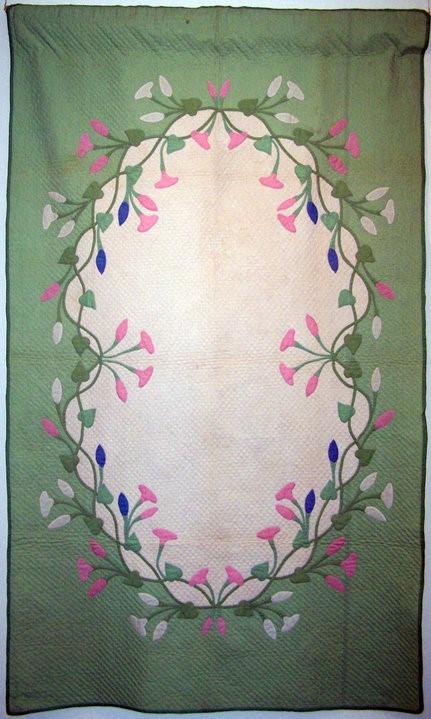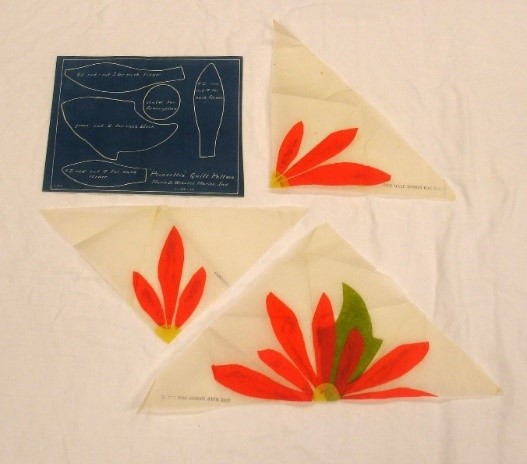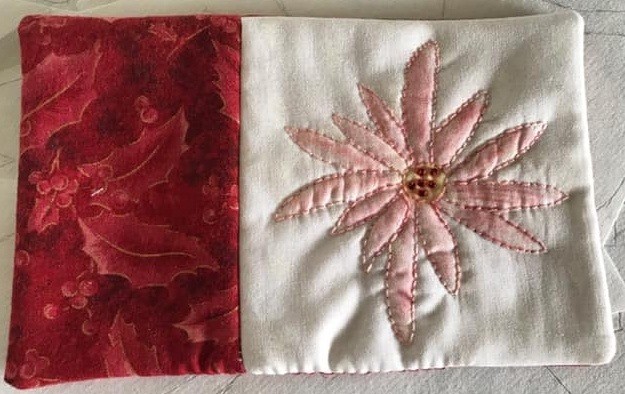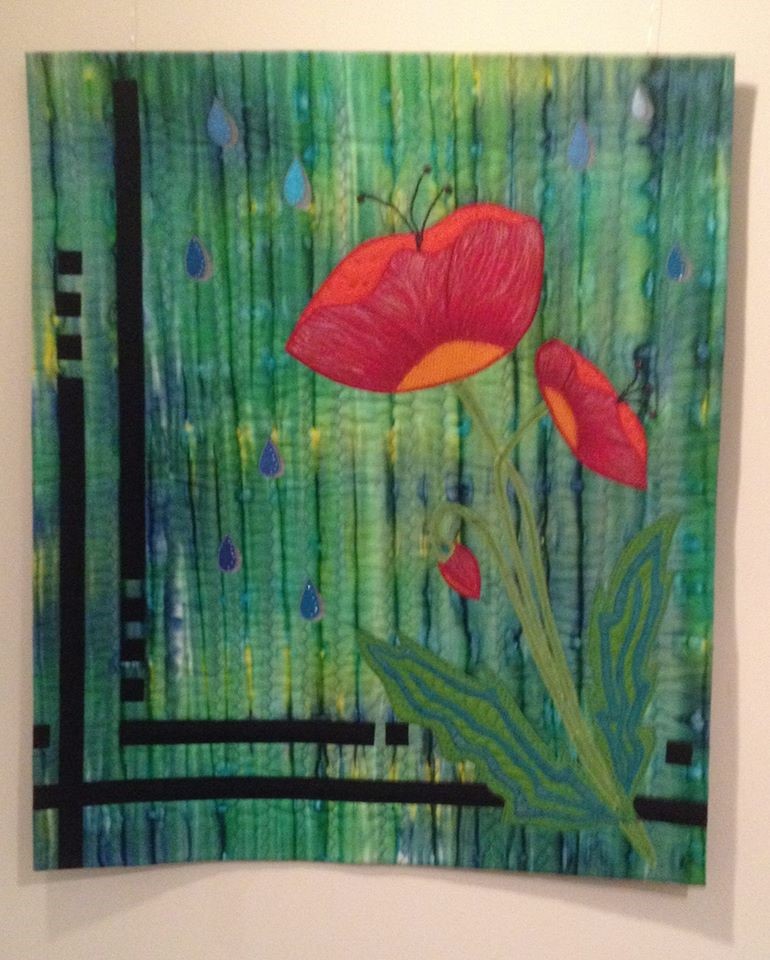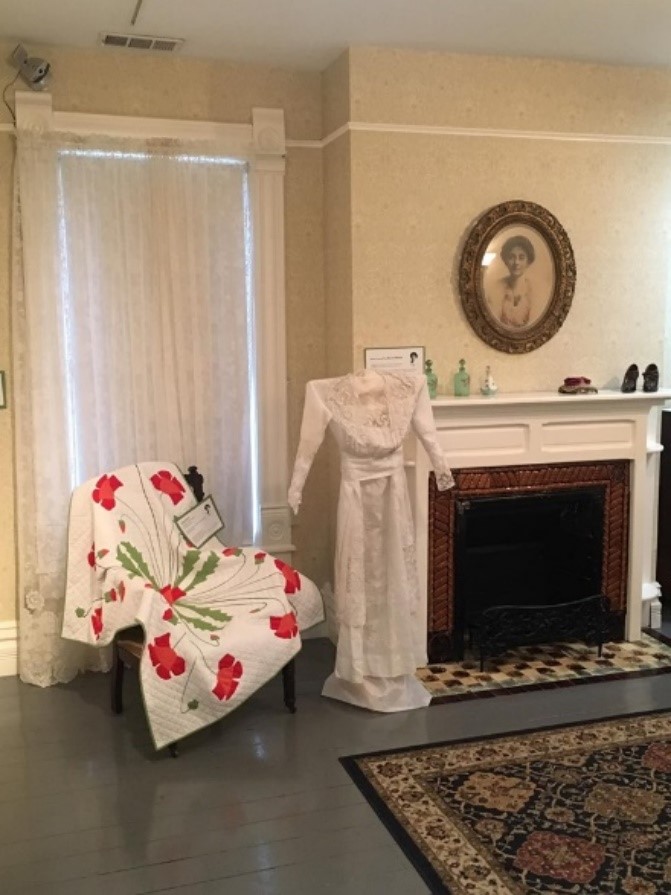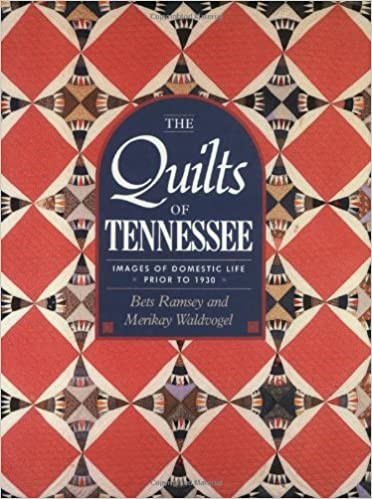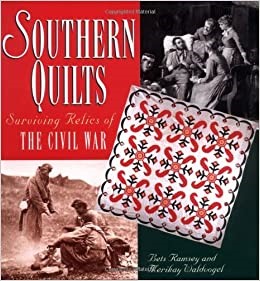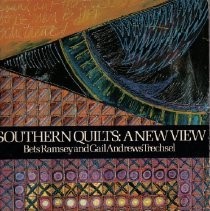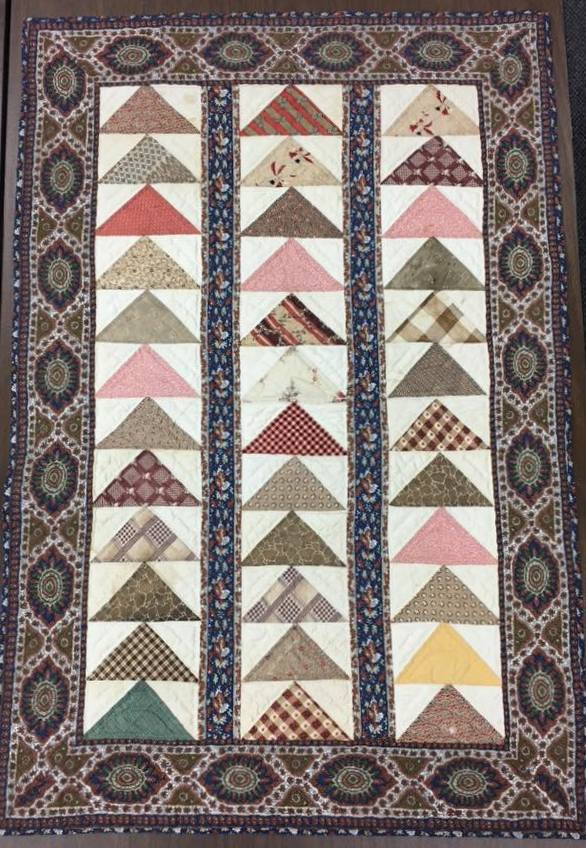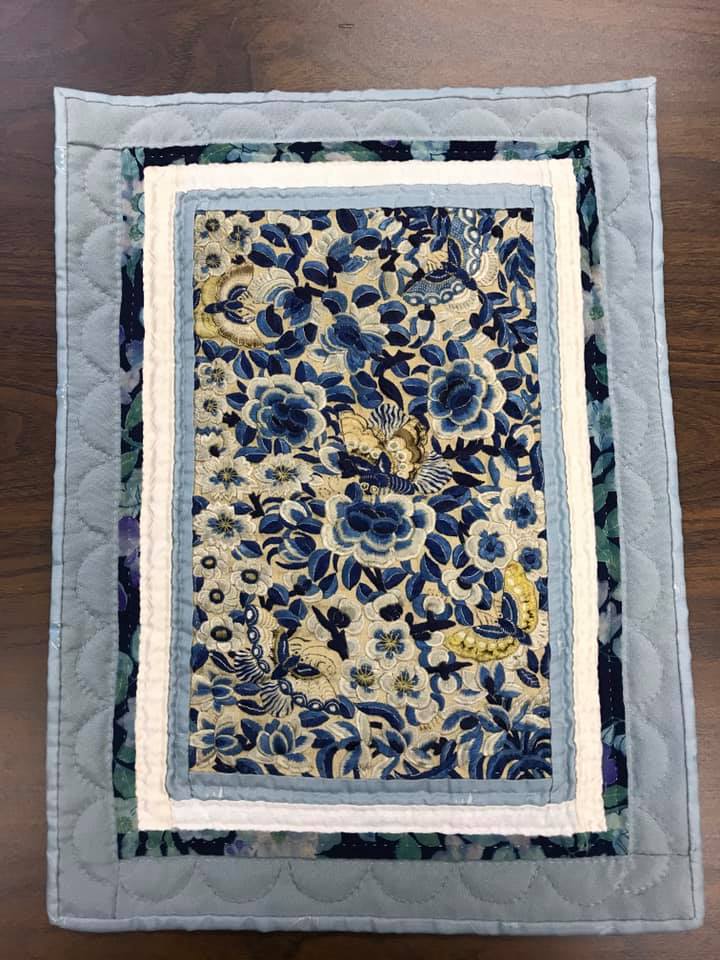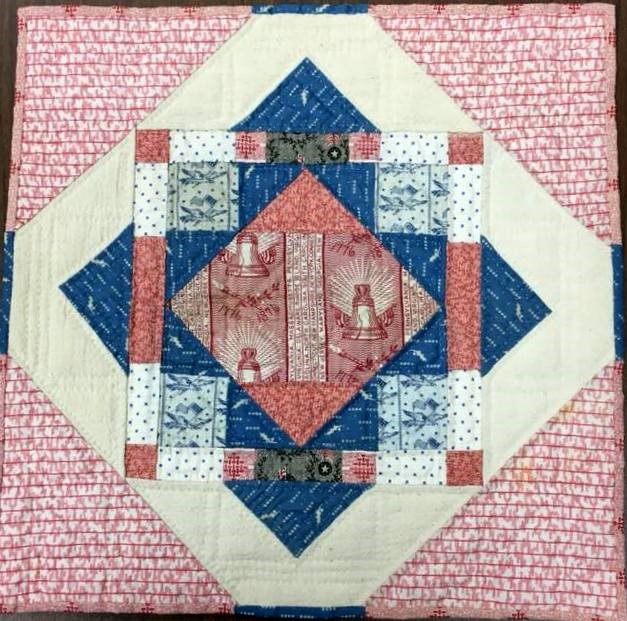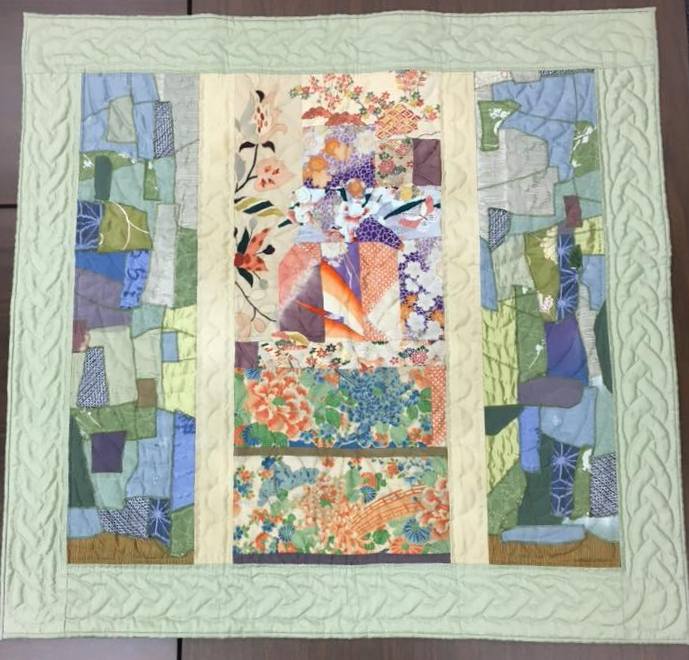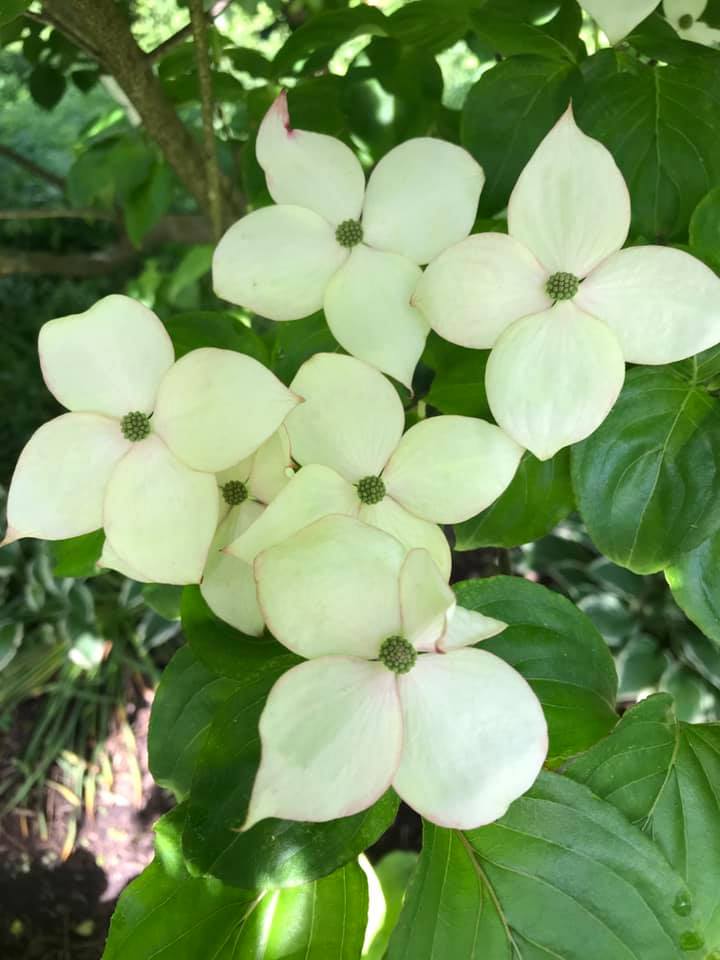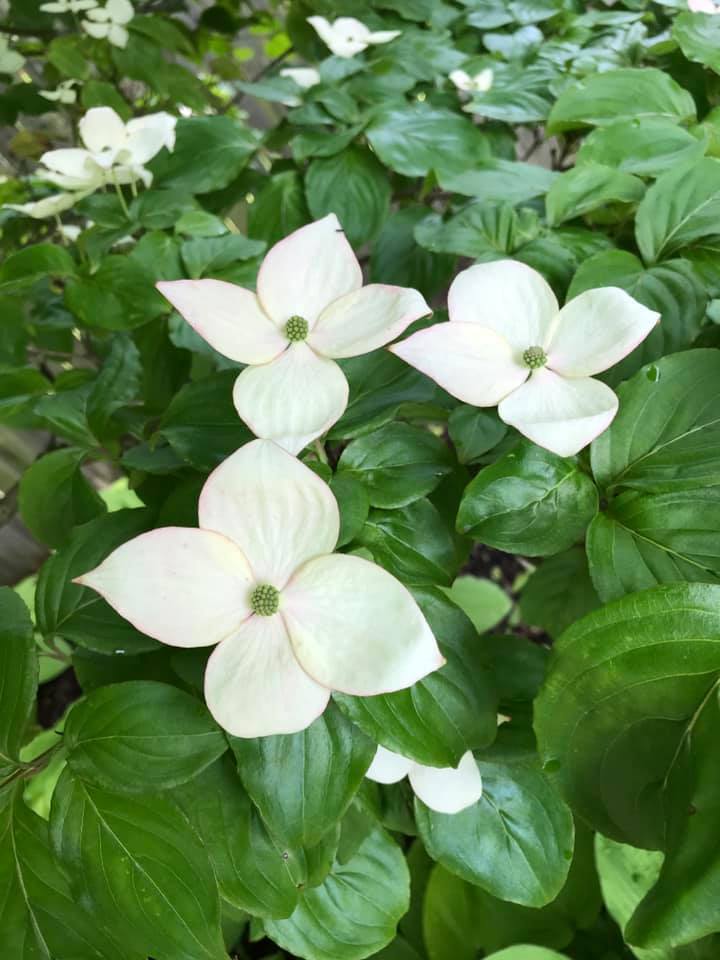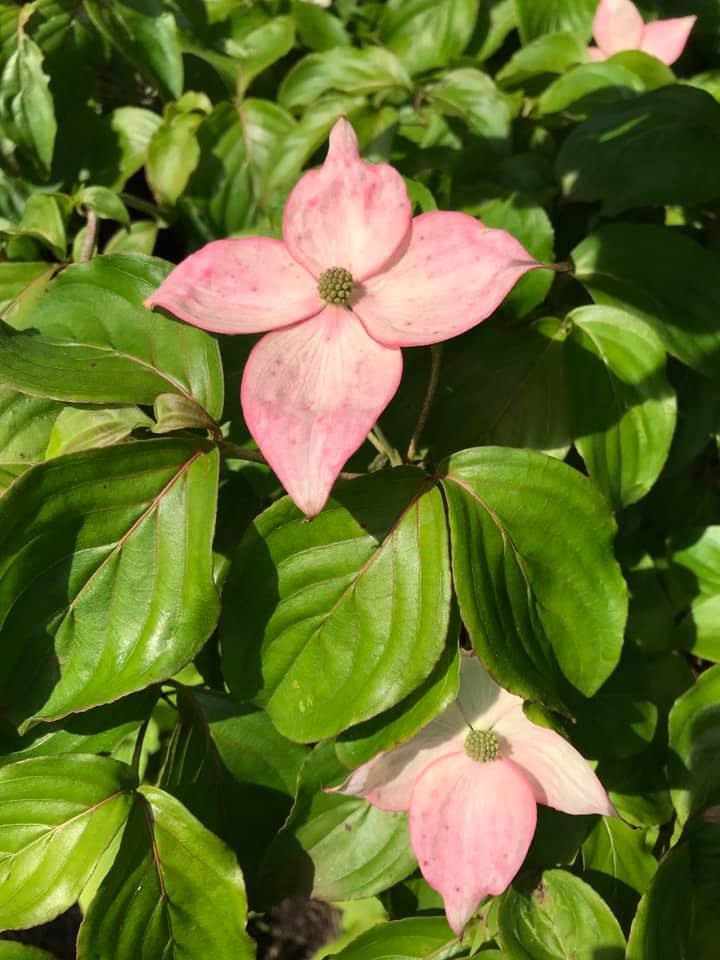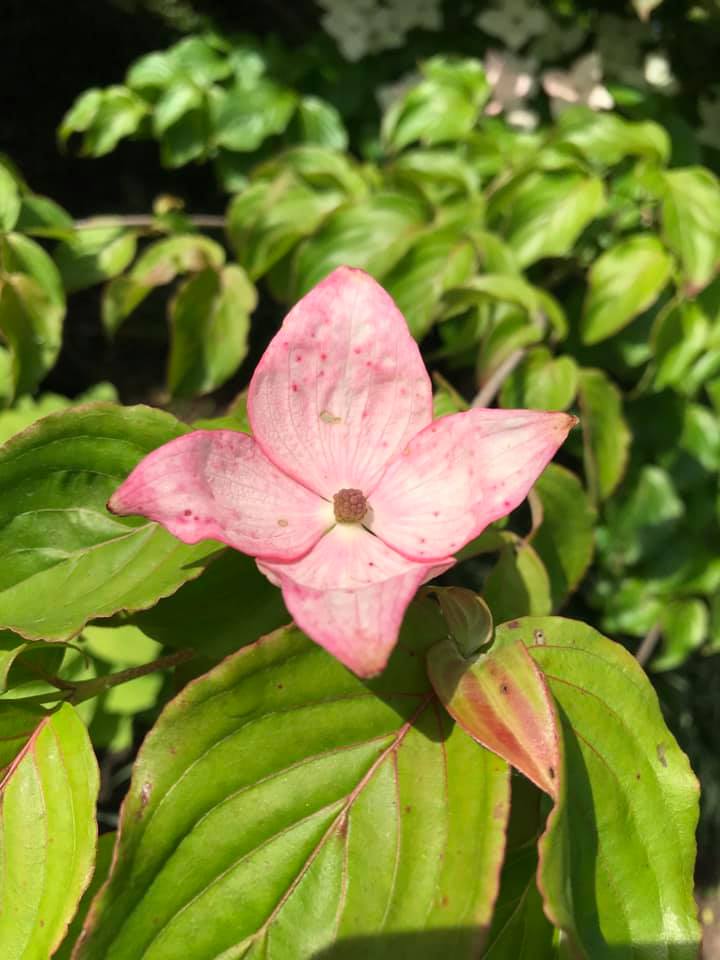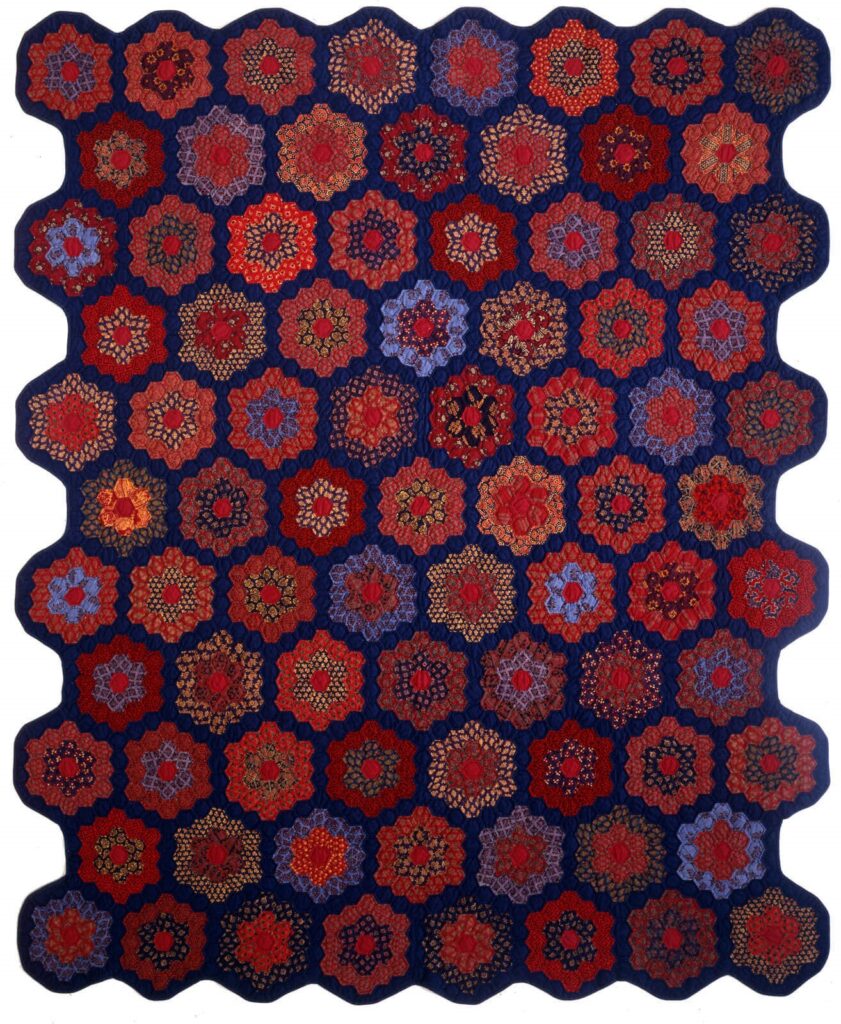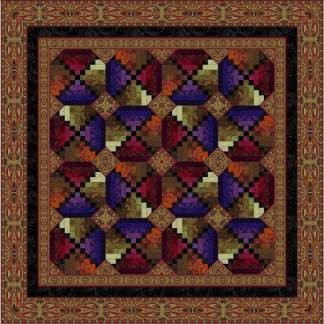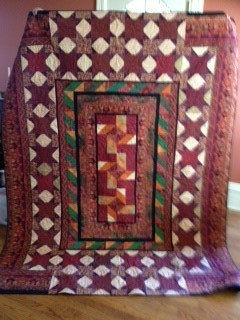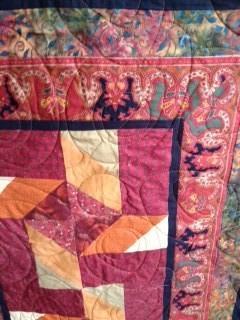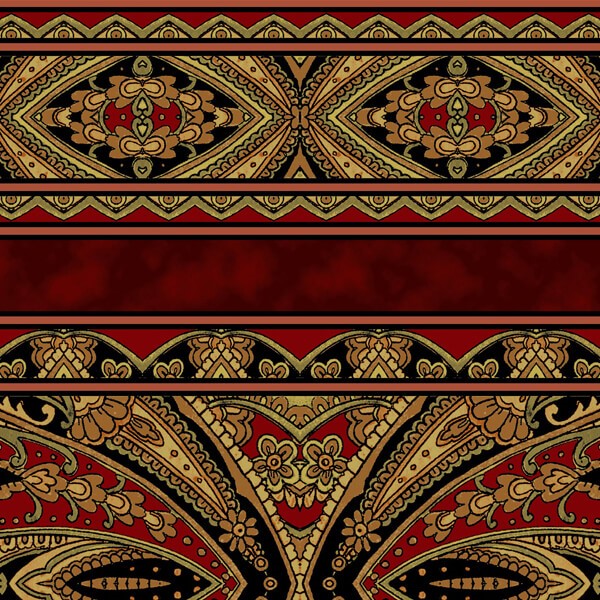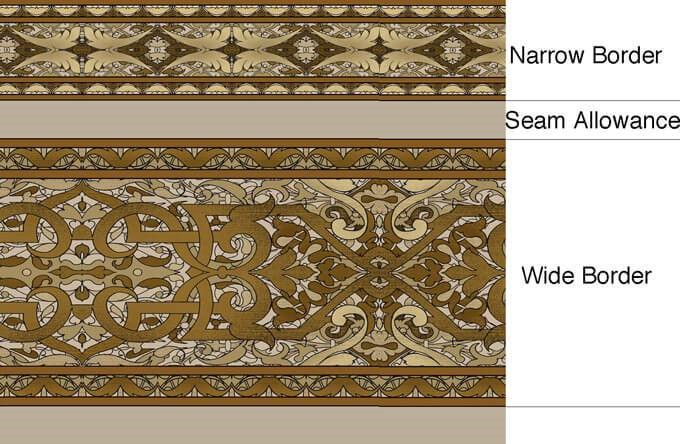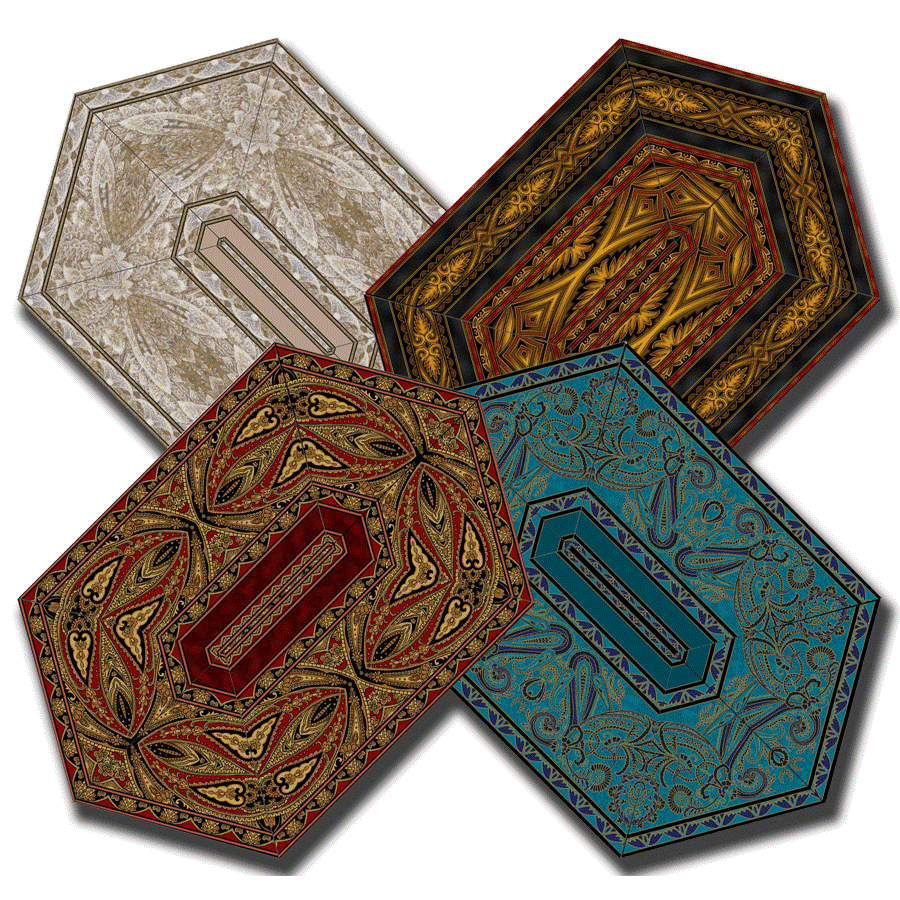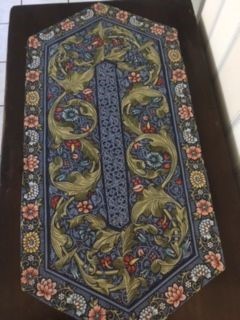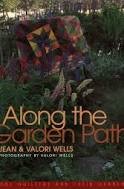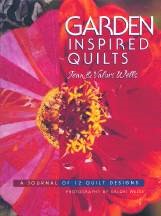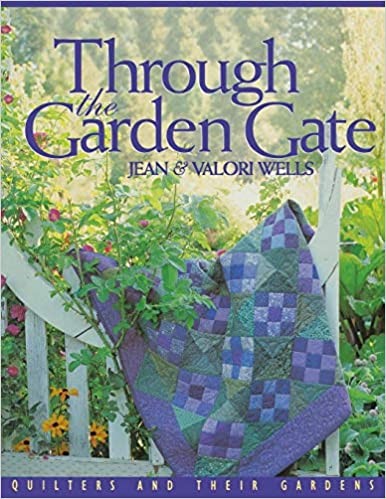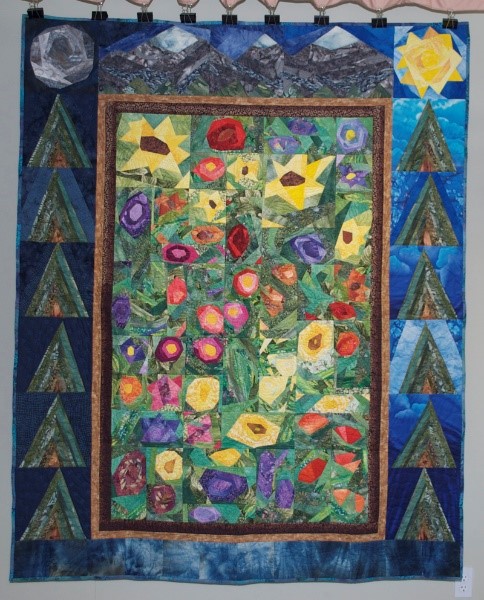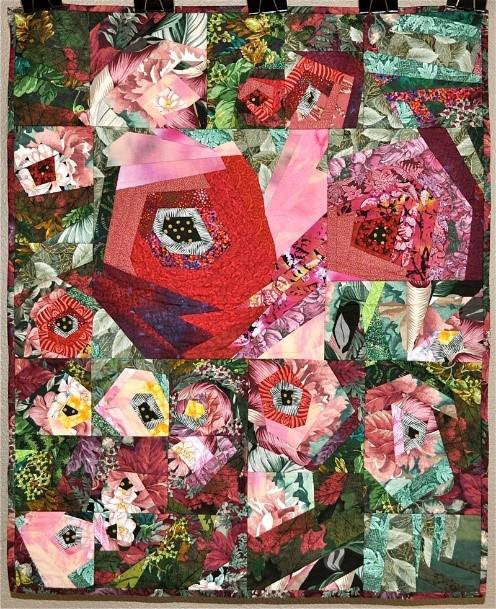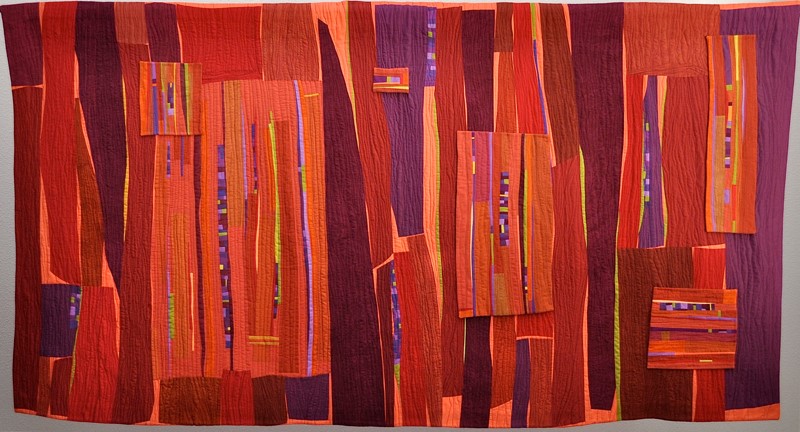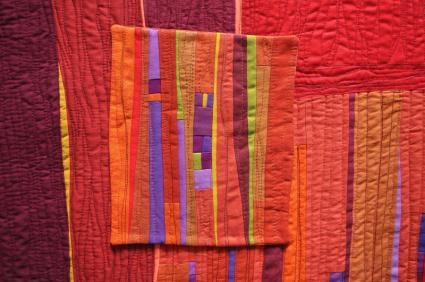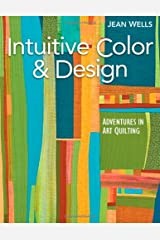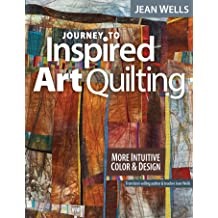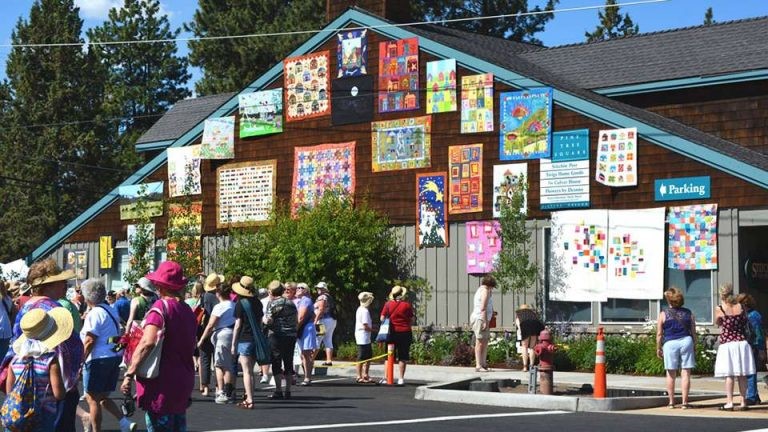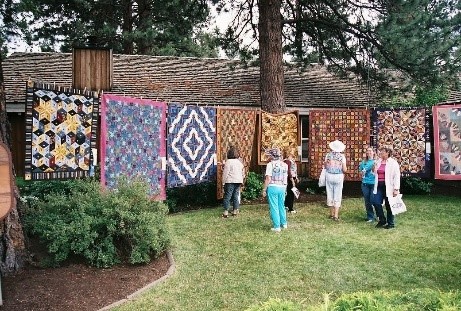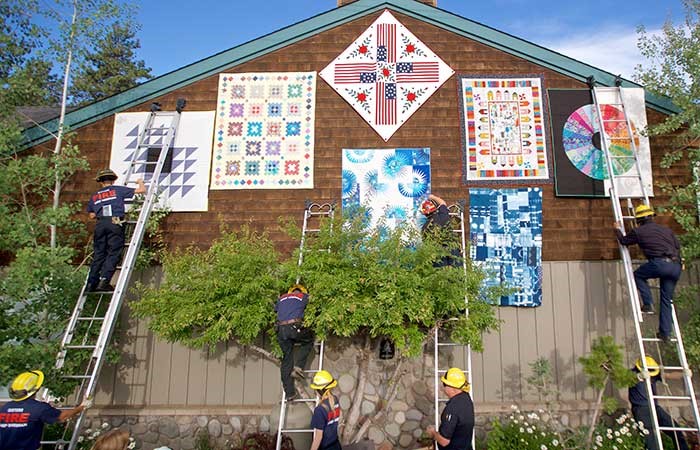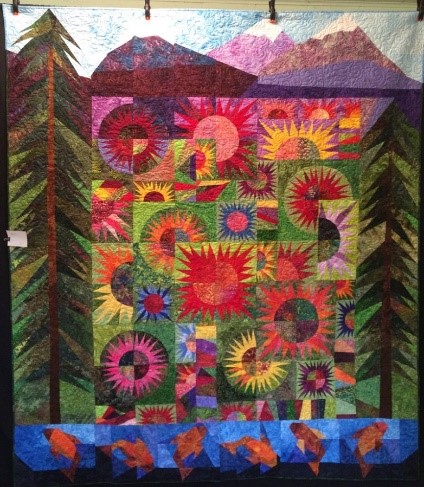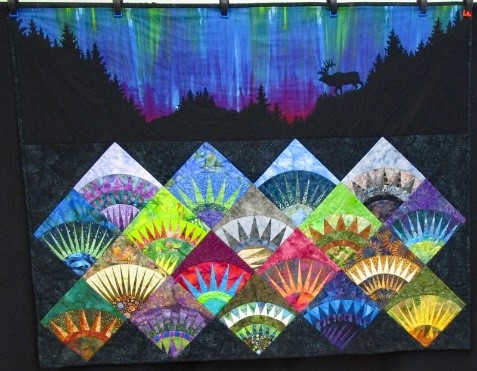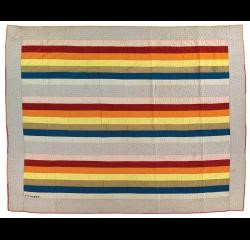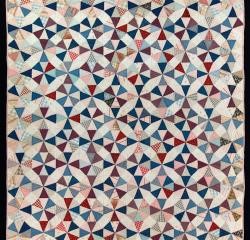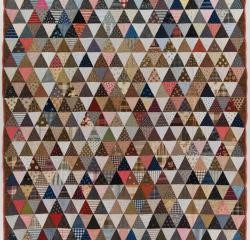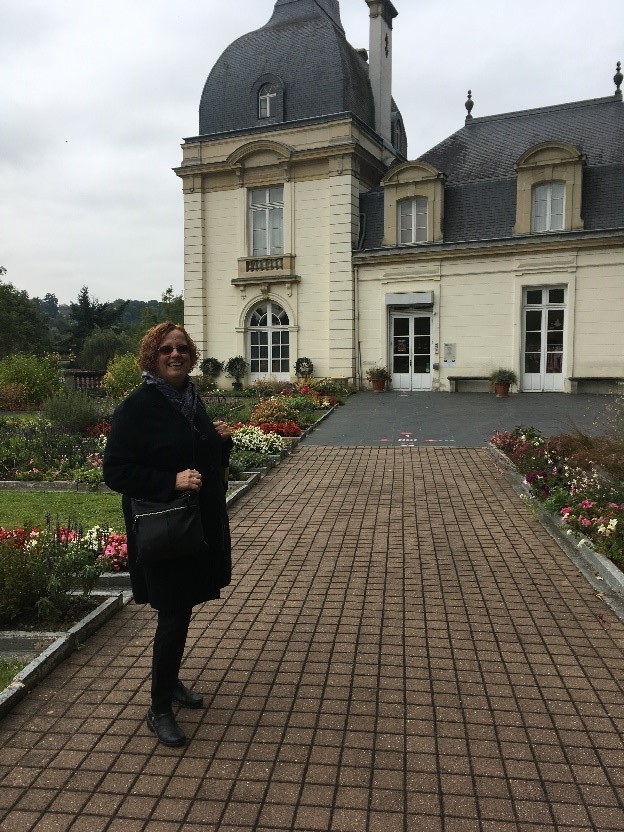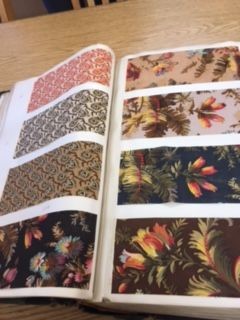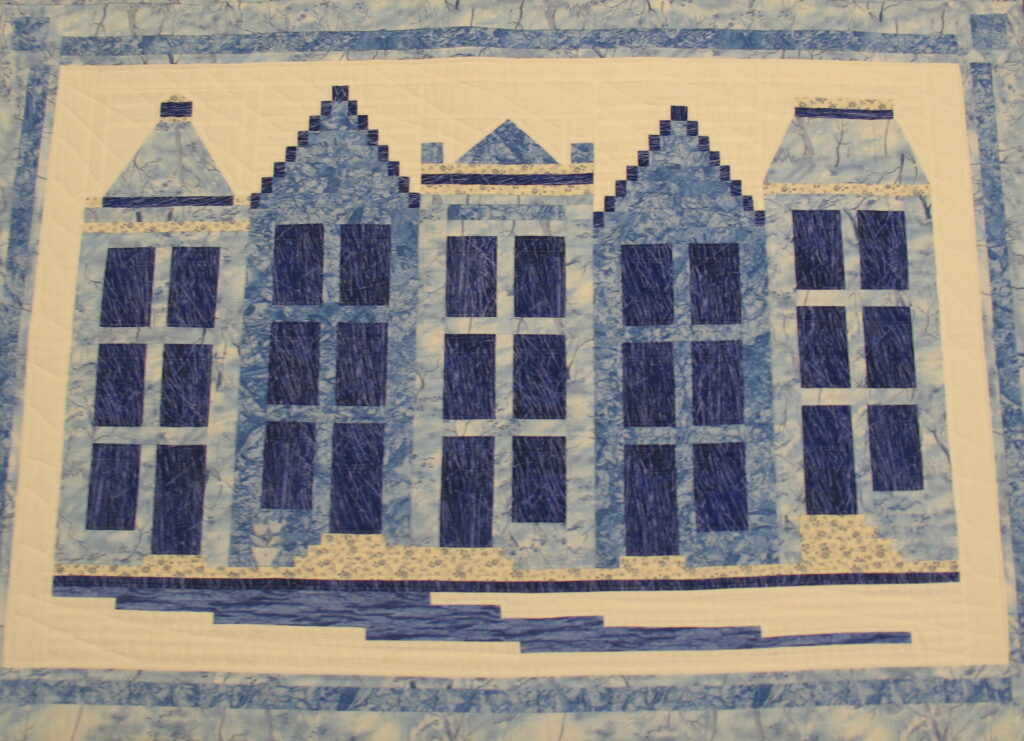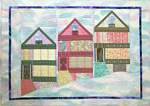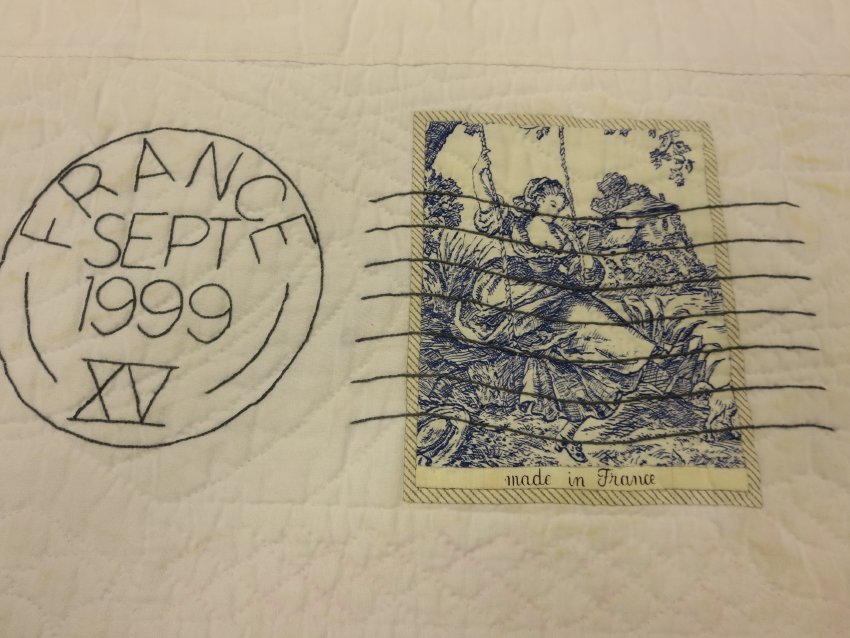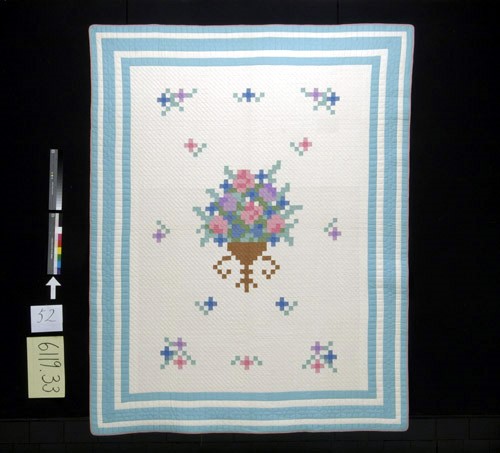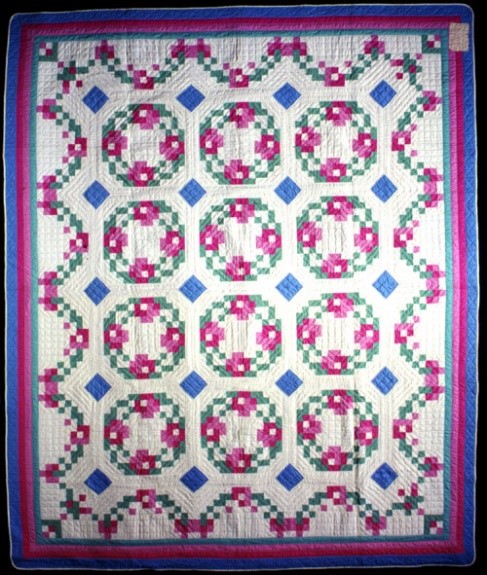Marie’s Garden
I had planned to write about Mary Barton who had a birthday last week, but I spent time weeding my garden, and that put me in mind of Marie’s Garden at the Hall of Fame. Let me show you a little of what’s blooming here, and then we’ll head to Marion.
When you park in the back lot at the Museum, you wander through what was Marie Webster’s original back yard. Take a pictorial stroll up to the house like this group of visitors did.
Did you notice the brick walk? There’s something special about it: the bricks are impressed with names, quotes, and dedications.
If you or your guild would like to have a brick engraved with their name, the cost is only $100 and the form is on our website: https://quiltershalloffame.net/brick-order-form/ (Also, if you have already purchased a brick, they are now all online in a searchable database: https://quiltershalloffame.net/bricks-in-the-garden/ )
We know Marie was a gardener. It’s said that her first quilt, American Beauty Rose, was inspired by her garden. She later submitted that design for a contest in the Ladies Home Journal magazine and caught the attention of the editor. The editor then requested three more designs from Webster, and she supplied “Iris”, “Snowflake” and “Windblown Tulip”; all were featured in the magazine on Jan. 1, 1911, turning Webster into a “national celebrity.” Here’s a photo of the article, followed by “Iris in Baskets” and “Windblown Tulip”.
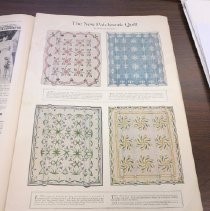
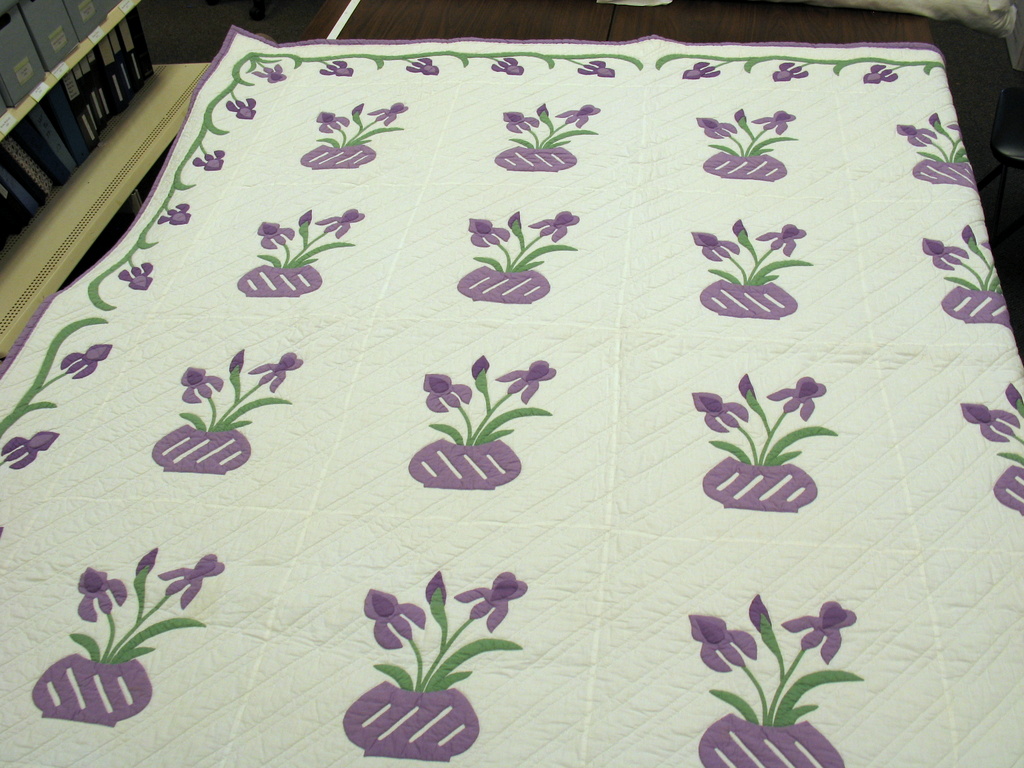
From the collection of The Quilters Hall of Fame.
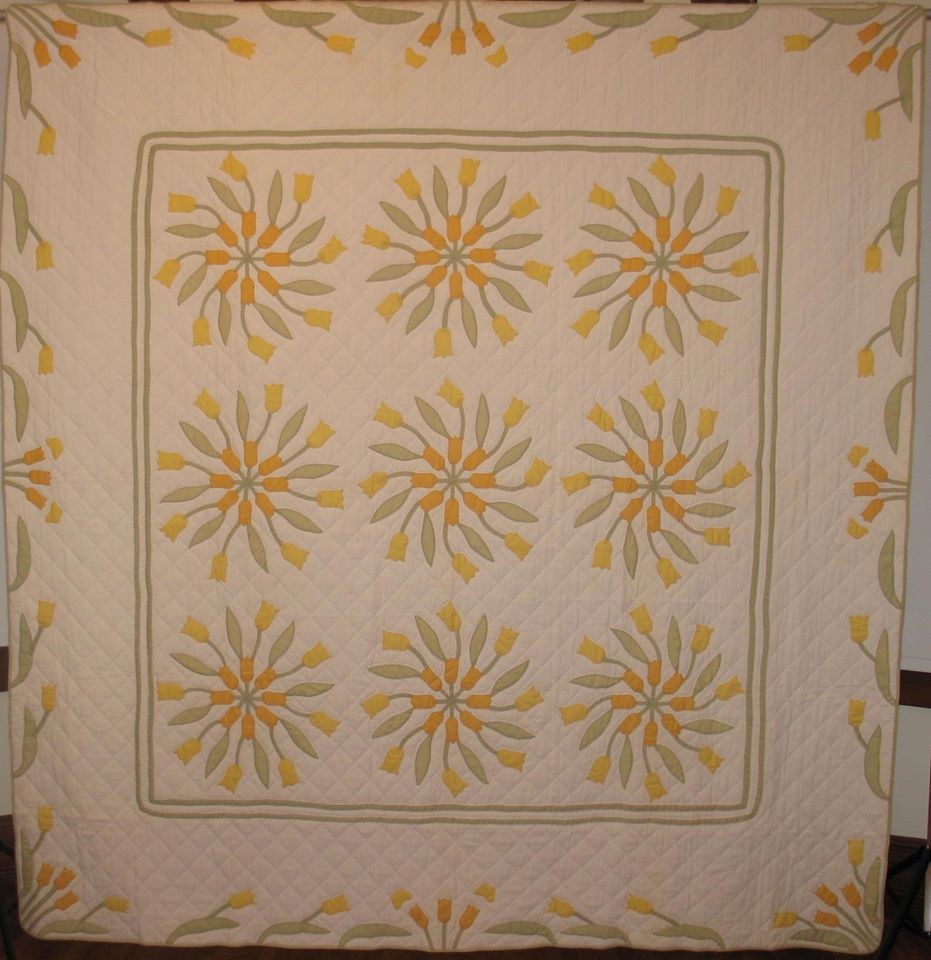
Back to the garden.
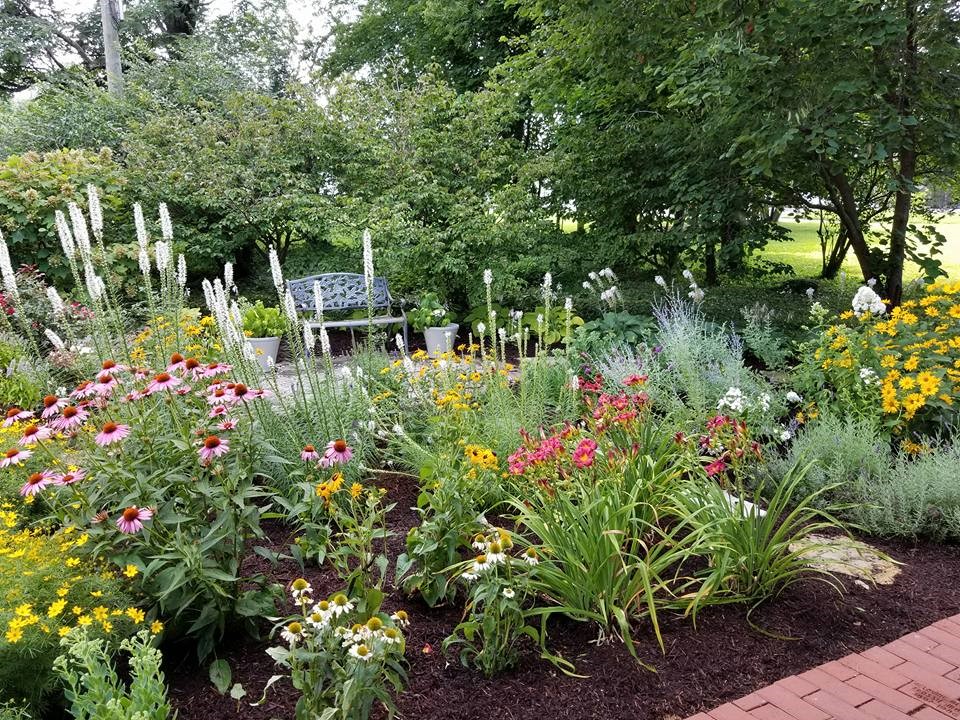
For all the beauty, I’m pretty sure this is not what the yard looked like in Marie’s time. Her style would probably have been simpler and somewhat old-fashioned, leaning more towards bedding plants and perhaps a border. The garden is now maintained by volunteers… thanks to every one of them! And while it is still a lot of work, many hands make the work lighter. But there is still one element of the original: hollyhocks. The seeds from which these plants were grown were found in the basement of the house when The Quilters Hall of Fame took ownership of the house. Are they left over from Marie Webster days?! In the fall we will sells seeds from these plants.
Now let’s take a look at how the garden inspired the famous Webster designs. What’s a garden without at least one rose bush? (Up until last year, I had 40, but it was just too much work, so I cut back to six.) After that first “American Beauty Rose,” Marie patterned “Magpie Rose,” “Cherokee Rose,” “Wreath of Roses,” “Cluster of Roses,” and “Wayside Roses.” Here are two of those quilts.
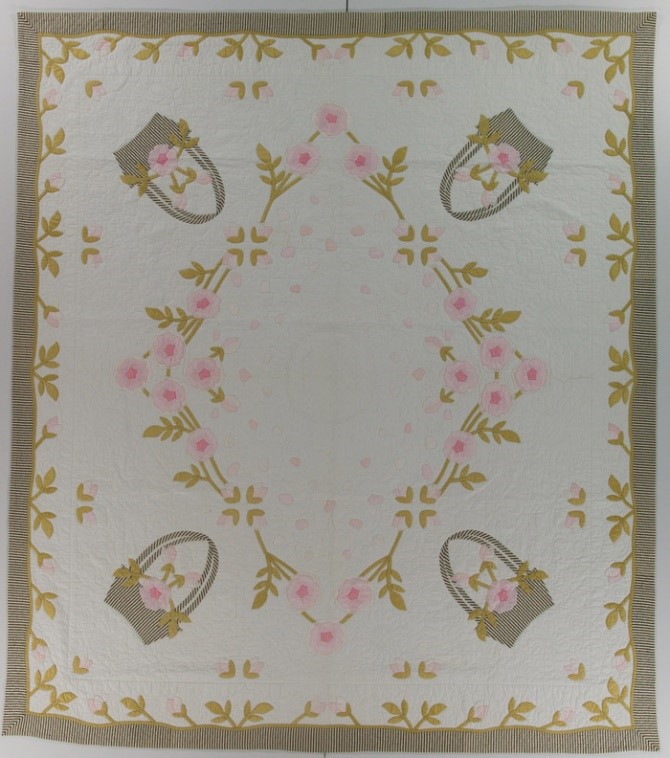
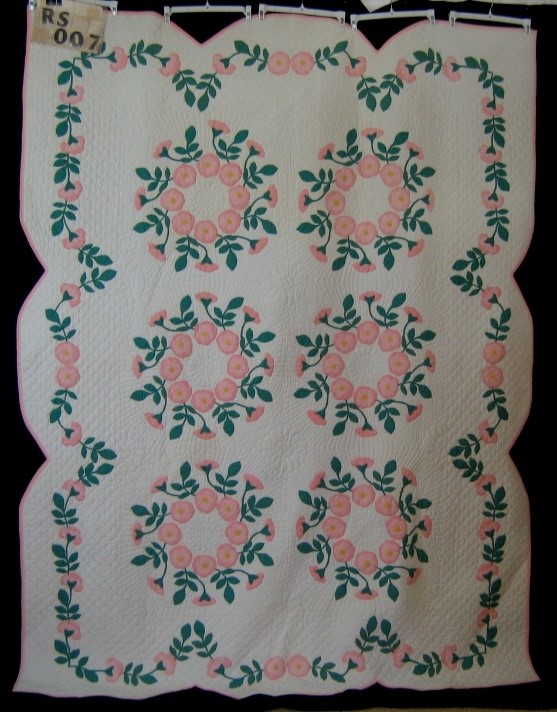
Daisies are another old-time favorite. An early daisy pattern is recalled today in clumps of daisies from Marie’s Garden.
And here’s a shot of the current dogwood tree along with an original pattern for one dogwood quilt, followed by a Webster dogwood quilt in a different setting. If you would like to see the complete Dogwood pattern, and two others (fascinating to imagine using those old templates), there are links at the end.
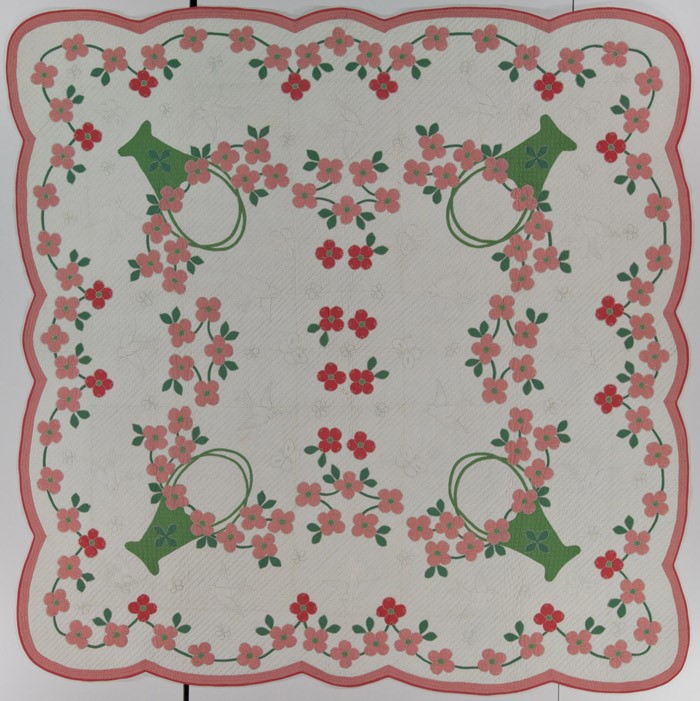
I imagine any old-fashioned garden would have poppies, and that flower inspired one of Webster’s most iconic quilts. Here it is in the yellow colorway; it’s also popular in pink and stunning in red.
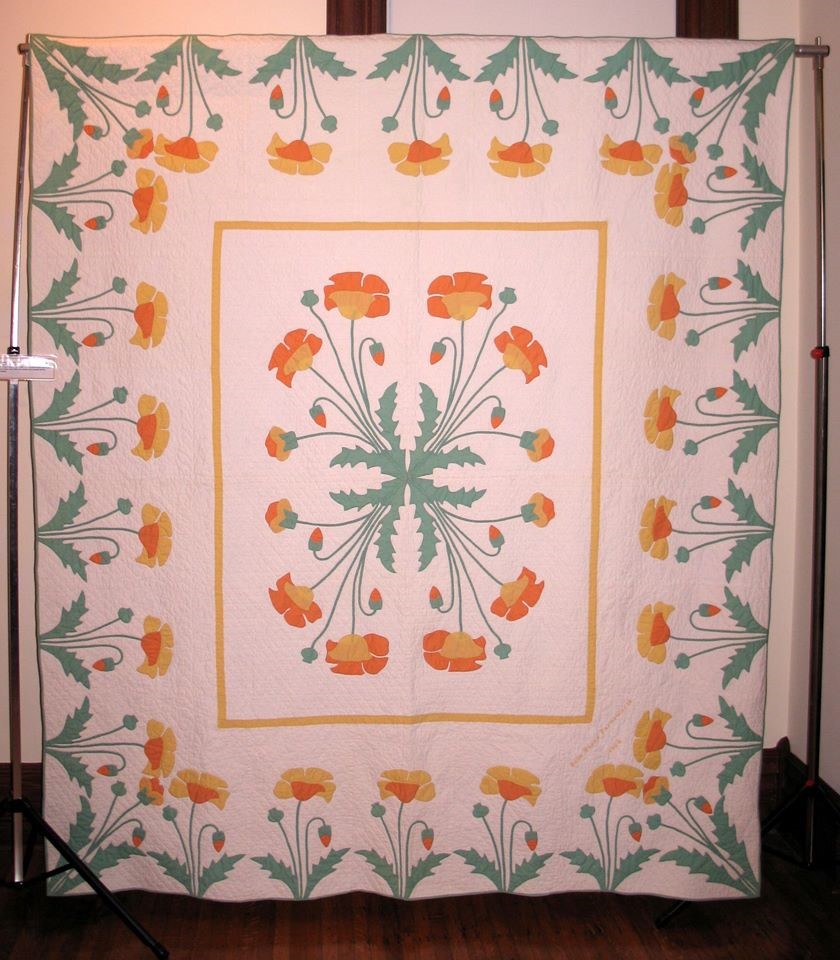
Marie didn’t just have a quilt design business; she actually made quilts. Here are some which might have come from her own flowers. Morning Glory, followed by two versions of Morning Glory Wreath. This graceful design first appeared in the Ladies’ Home Journal in August 1912, along with five other baby quilts she designed. Marie made this larger version of the pattern for her granddaughter, Katherine Marie, about 1940. From the collection of Katherine Webster Dwight.ned.
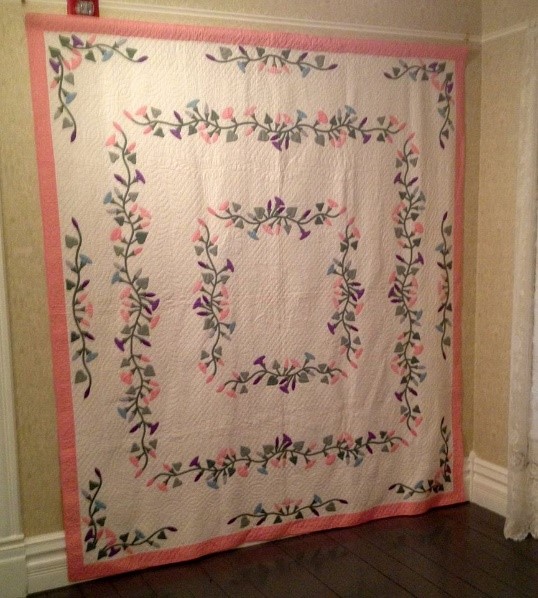
On the right, “Morning Glory Wreath” made by Marie Webster for her granddaughter, Katherine Marie, about 1940. From the collection of Katherine Webster Dwight.
Here are two more Webster-made quilts based on popular flowers, nasturtiums (I’ve grown them; they’re edible) and pansies (an early-spring pop of color).
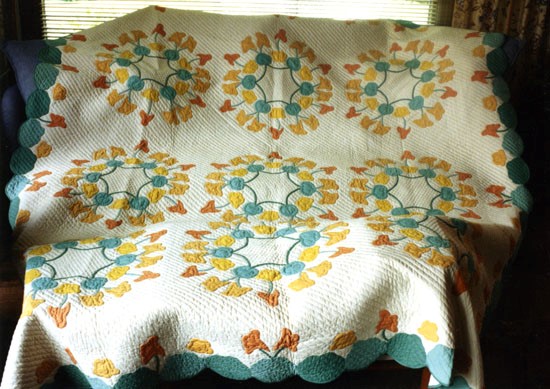
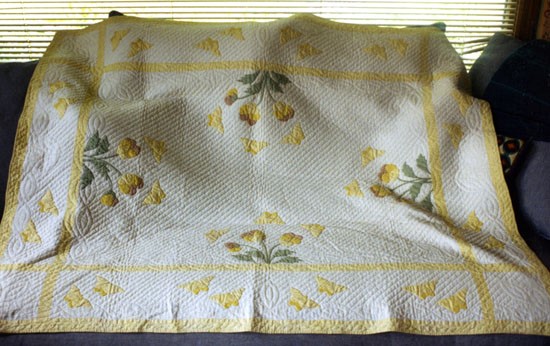
Of course, there are other popular designs growing in the Webster flower bed: more tulips, sunflowers, baskets of blossoms.
Marie Webster’s designs have a timeless appeal in and of themselves, but her style is not in vogue today—maybe more white than we want, maybe too ordered. But her flowers still work in present day contexts. A friend of the Hall of Fame collaborated with one of Marie’s granddaughters on this book which adapts the designs to pillows, small quilts and other contemporary uses.
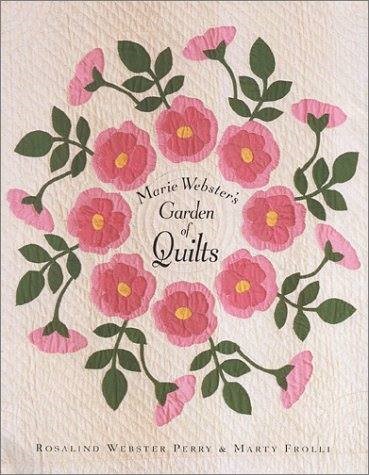
I saw one of the designs at the Museum a few years ago, and it’s a great sampler of Marie’s flowers. The addition of the ticking fabric gives it a fresh, modern look.
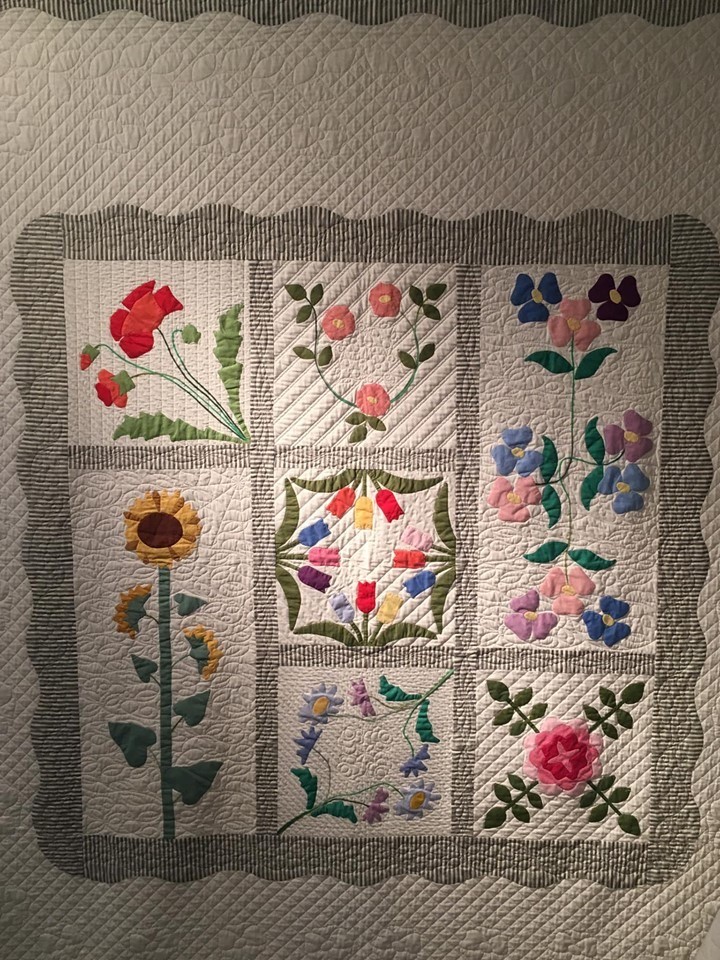
And in Fall, 2017, there was a juried exhibit called Dialogues: Contemporary Responses to Marie Webster’s Quilts with contemporary quilts by Midwestern members of the Studio Art Quilt Associates juxtaposed with Marie’s designs. Here are some photos from that exhibit to show you how the two styles both capture the essence of the flowers.
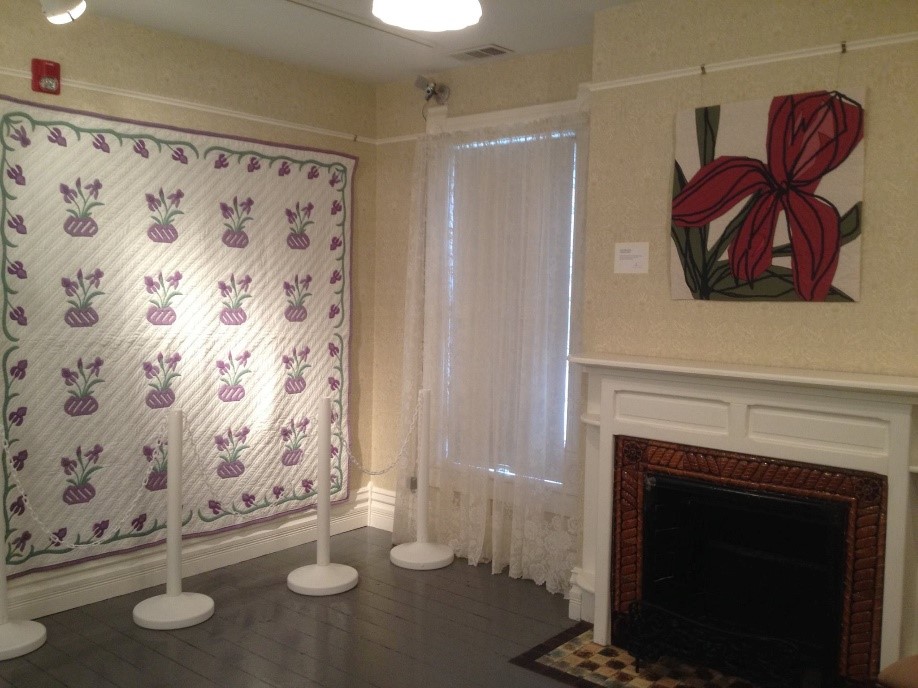
“Iridaceous” designed and made by Linda Witte Henke on the right.
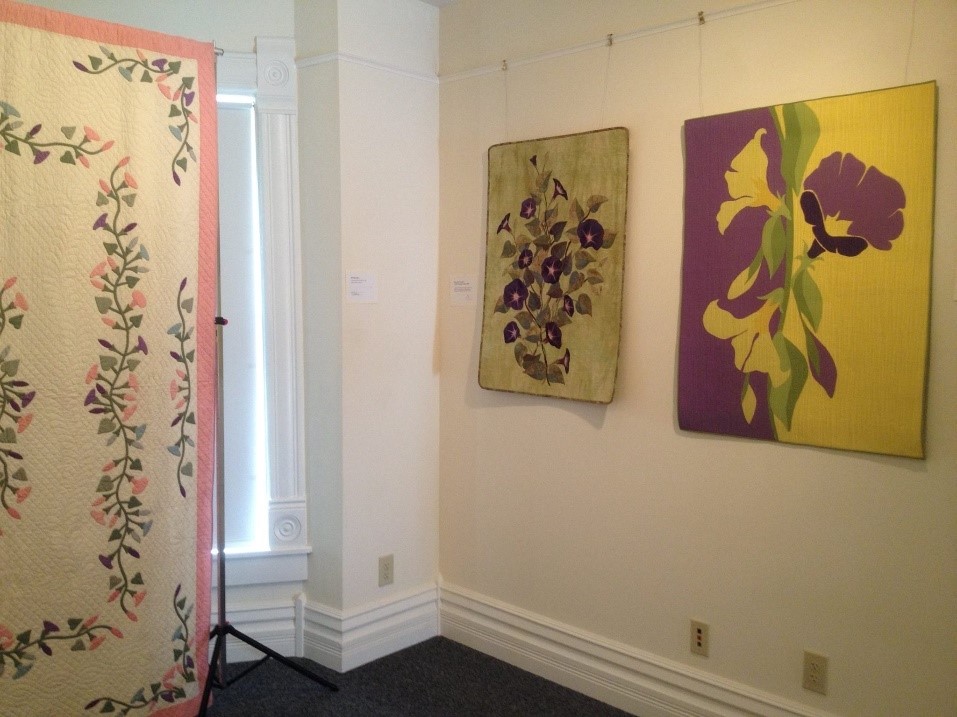
“Purple Trumpets of Glory” designed and made by Mary Ann Van Soest in the center. “Morning Glories: A Joy Forever” designed and made by Joanne Alberda on the right.
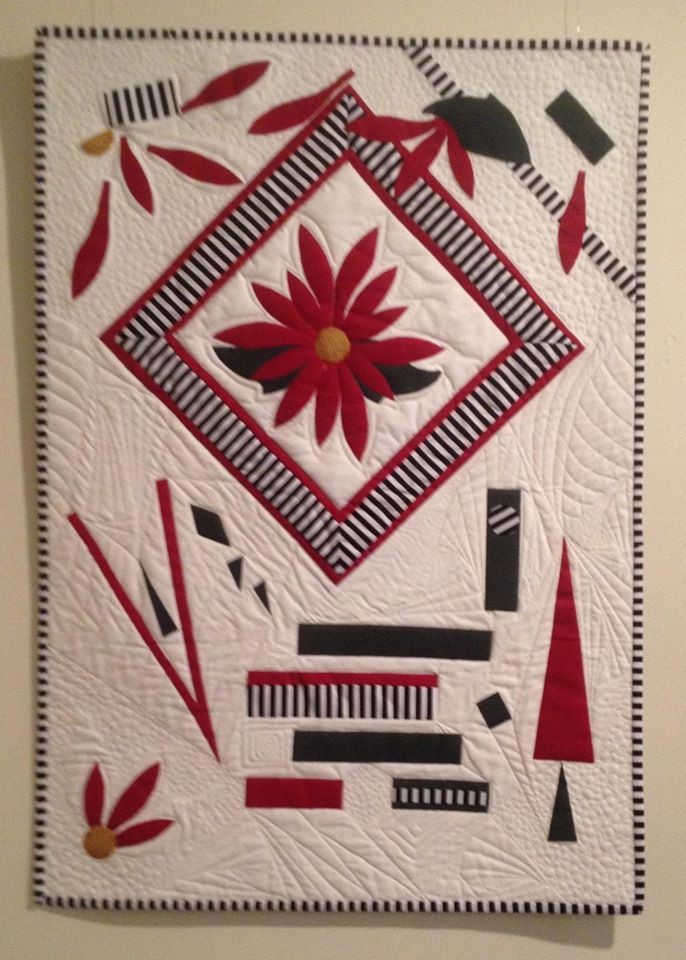
On the chair, “Poppy” quilt from the Quiltsmart Marie Webster Series, inspired by Marie’s original designs using Quiltsmart printed interfacing.
I hope you’ve enjoyed this walk through Marie’s Garden of quilts. When you’re able, try to visit in person. It even looks good in the winter.
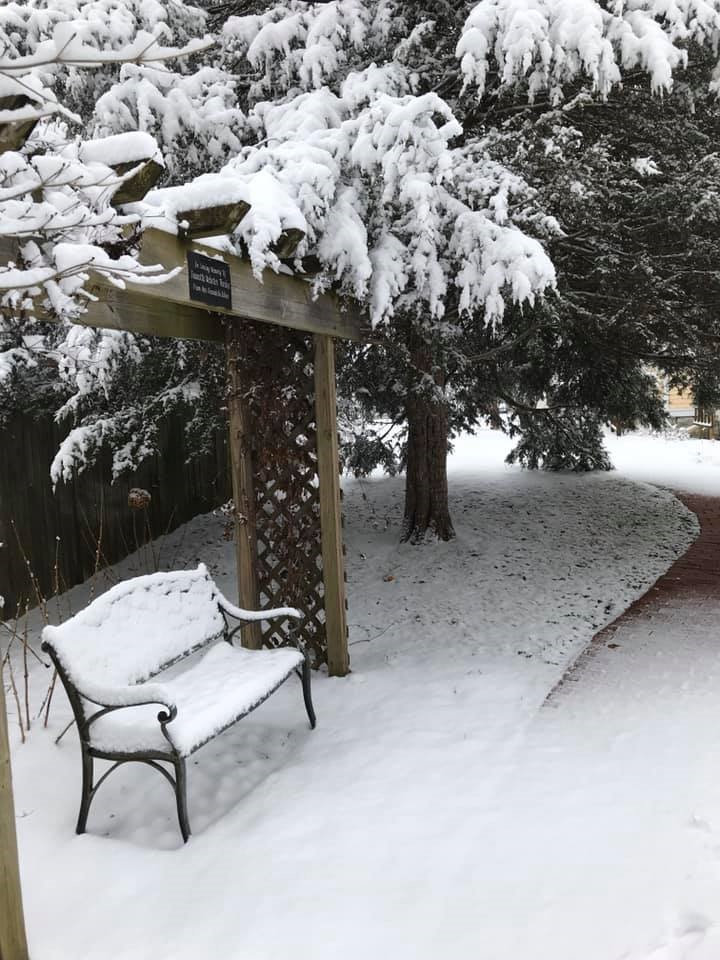
Your quilting friend,
Anna
Suggested links:
“American Beauty” pattern https://quiltershalloffame.pastperfectonline.com/webobject/42E3C360-77E5-45E7-ACEE-559504503319
Complete “Dogwood” pattern https://quiltershalloffame.pastperfectonline.com/webobject/52FC825B-AA24-4391-BC00-995383132853
“Pink Dogwood” kit https://quiltershalloffame.pastperfectonline.com/webobject/2D593DFC-0BB6-46D6-9F70-172460710460
Write About What You Know
Honorees Mary Barton and Bets Ramsey share a birthday today, June 9th. I thought to write about them together, but there’s too much to say about each of them. I’ll start with Bets, and get to Mary next week.
Before I start though, I want to thank all the gals in my guild (shout out to you, Faithful Circle) who helped with suggestions on how to improve this blog. For one thing, I was told that the links I include would be better at the end, so the reader isn’t skipping away from the Hall of Fame site; I’ll try that this time. Also, administratively we are going to add more “tags” to make it easier for someone browsing the internet to find us. If you have other ideas to help us increase visibility or to provide better information, please leave a comment. Now, on to Bets Ramsey, who turns 90 today and is the 2005 inductee.
You can read a full biography of Bets on the Honoree page of the Hall of Fame website (link below) or get a visual recap of her life in the video (another link below). But I want to focus on one big part of her life: her writing. Bets is best known for her authorship of books on quilts in the South. She was born in Tennessee, and lives there today, so she was writing about what she knows. Here are three in the Hall of Fame Collection.
The first of these books, Quilts of Tennessee, derived from a four-year project documenting, with Hall of Fame Honoree, Merikay Waldvogel, almost 1500 quilts in their home state. If you search the Quilt Index (link below), you’ll discover over 250 Tennessee quilts that they documented. And, just because no blog of mine is complete without a Quilt Index citation, here’s one of the earliest they found; look at that quilting!
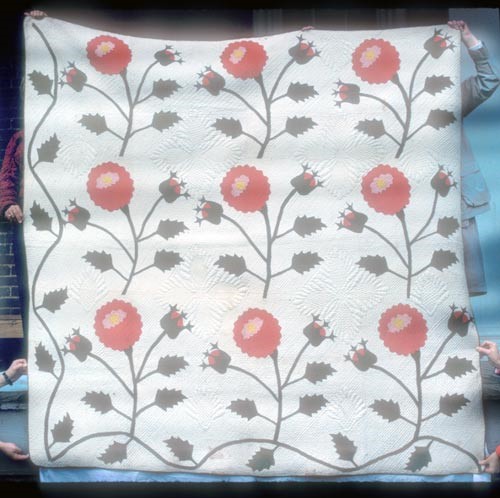
Much of this documentation was spun off into six scholarly articles published in the American Quilt Study Group research journal, Uncoverings. The first of these, “Design Invention in Country Quilts of Tennessee and Georgia”, attributes a characteristic of country quilts observed by Ramsey: compromise brought on by necessity. She gives as examples the use of cut outs (broderie perse), string piecing and natural dyes. There’s a certain effort at organization, and her premise couldn’t be fully developed in an eight-page essay, but what really comes across, is the soft spot Bets had in her heart for the cherished family quilts she was learning about, and her respect for the quiltmaker-artisans she interviewed.
Again, writing about what she knew, in “Recollections of Childhood Recorded in a Tennessee Quilt”, Ramsey detailed a project spearheaded in her capacity as crafts specialist with the Senior Neighbors of Chattanooga, Inc. Her thought was, “Every quilt is a piece of history. It is a record of the fabric of a given period. Its pattern and design reflect the style of the time. The quilt is an essay about the maker’s ability, training, taste, and feelings.” But for this project, she wanted a quilt which would visually record history. Jumping off from the tradition of Baltimore Albums and other quilts which depicted items of symbolic significance or the maker’s contemporaneous surroundings, she invited a group of mostly blacks who had grown up in rural areas to make a quilt depicting a story from their youth. The article with charm and a tremendous feeling for the quiltmakers describes many of the stories that came out during the making of the quilt. Why isn’t this quilt on the Quilt Index?
Next came “Roses Real and Imaginary: Nineteenth-Century Botanical Quilts of the Mid-South”, a comparative study of the influence of rural and agrarian life on chosen quilt patterns, interspersed with diary entries mentioning the quilts being made. And then “The Land of Cotton: Quiltmaking by African-American Women in Three Southern States”, based on oral interviews with rural quiltmakers who had moved to the city. In both cases, Bets was writing about what she knew, or rather, what she went out and gleaned.
Bets also knows about art. Her grade school and high school years were spent in Oak Park, Illinois (famous as the home of Frank Lloyd Wright) and she decided early on to be an artist. In that vein, her fifth AQSG publications for Uncoverings was “Art and Quilts: 1950-1970”. I don’t think of those years as being a flourishing time for quilts of any style, let alone art quilts, but Bets was writing about what she knew, from her personal acquaintances, her experience with mounting the Holstein/ Van der Hoof exhibit when it travelled to Tennessee, and decades of craft work. Her remaining article, given as a special presentation at AQSG was a recognition of fiber artist Mariska Karasz.
Bets doesn’t just write about quilts, she actually makes them, and takes this artistic endeavor seriously. She even has a Linkedin profile describing herself as a fiber artist, but I’m not savvy enough to get there. Although my focus was intended to be about her writing, it wouldn’t be fair to leave you without a quick view of some of her work.
Artists, unlike the rest of us, often work in series to try out their ideas, and Bets is no exception. Whether she planned it deliberately or not, she has produced a number of items from other people’s scraps.
First is “Wild Goose Chase” with pieced strips made by Elizabeth Richardson and given to Peto. (As an aside, I’m sharing 30’s Christmas fabric with friends as a challenge. Do you ever do that?) And then, a little quilt made of a chunk of fabric from one of Marie Webster’s dresses. At the bottom is “Peto’s Centennial Challenge”, made from Hall of Fame Honoree Florence Peto’s scraps from her challenge to Bertha Stenge (another Honoree) and Elizabeth Richardson. The Quilters Hall of Fame boasts a dozen more of these scrap quilts, and there’s a link below. Sometimes, if we’re especially lucky, Bets will contribute a piece for the annual fund-raiser live auction; keep your fingers crossed and eyes peeled.
And now for something completely different, “Valley of Forgotten Dreams”. (Well, not completely; it does use scraps of kimonos.)
And, “Fog Days on Cranberry Island” will round us out where Bets’ artistic career got started in 1967 when she and her family summered off the coast of Maine, and she participated in local arts and crafts fairs.

If you want to see more of her quilts and hear Bets talk about them, there’s a great video link below.
Phew, I didn’t even tell you about her lectures and quilt columns! Maybe another time. But for now, let’s just all wish Bets a Happy Birthday.
Your quilting friend,
Anna
Links mentioned above; if you can’t Control+Click, then cut and paste the reference into your browser.
Hall of Fame Honoree site https://quiltershalloffame.net/bets-ramsey/
Gov. Award video https://www.youtube.com/watch?v=GihxVuJxYeA
Documentation of Tennessee Quilts (all listed as Tennessee State Library and Archives) http://www.quiltindex.org/search_results.php?keywords=Bets+RAmsey&search=go
Art and Quilts http://www.quiltindex.org/journals/article.php?Akid=2-B-C7
Design Invention in Country Quilts of Tennessee and Georgia http://www.quiltindex.org/journals/article.php?Akid=2-B-FF
Recollections of Childhood Recorded in a Tennessee Quilt http://www.quiltindex.org/journals/article.php?Akid=2-B-12F
Roses Real and Imaginary: Nineteenth-Century Botanical Quilts of the Mid-South
http://www.quiltindex.org/journals/article.php?Akid=2-B-11A
The Land of Cotton: Quiltmaking by African-American Women in Three Southern States http://www.quiltindex.org/journals/article.php?Akid=2-B-98
A Tribute to Mariska Karasz (1898-1960)
http://www.quiltindex.org/journals/article.php?Akid=2-B-AB
Ramsey’s Peto/ Richardson fabric collection quilts https://quiltershalloffame.pastperfectonline.com/webobject?utf8=%E2%9C%93&search_criteria=Bets+Ramsey&searchButton=Search
More quilts video https://www.youtube.com/watch?v=dT93EchD7b8
The Dogwoods are Blooming in Marie’s Garden
Marie Webster loved the flowers of the Dogwood tree, among the earliest to bloom each spring. She loved them so much she designed two quilts featuring Dogwood flowers.
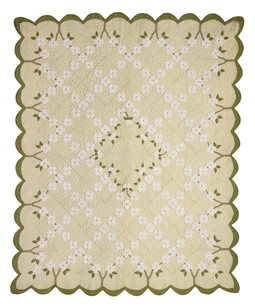
White Dogwood, pictured above, was first published in January, 1912 in Ladies’ Home Journal. Instead of a traditional square block format, White Dogwood has blocks set on point with the center block reserved for special quilting. The on-point blocks create a lattice of intersecting branches dotted with pink-tipped blossoms. The background is pale green linen, the branches are of heavily textured linen suggesting bark, while the petals are of smooth white cotton. This was her first quilt with a scalloped border. More information and the pattern for this quilt can be found in A Joy Forever: Marie Webster’s Quilt Patterns by Rosalind Webster Perry and Marty Frolli.
Some 15 years later, Marie was once again inspired by the dogwood’s beauty. “Pink Dogwood in Applique for the Bedroom” was featured in the Ladies’ Home Journal issue of September 1927, pictured on a four-poster bed. In this strong design four large baskets anchor the corners of the quilt. Light pink flowers tumble out of the baskets to form a large wreath, surrounding a neat arrangement of dark pink blooms in the center. In the border, garland of light and dark blossoms echo the curves of the scalloped edges. The pattern for this quilt can be found in the book Marie Webster’s Garden of Quilts by Rosalind Webster Perry and Marty Frolli.
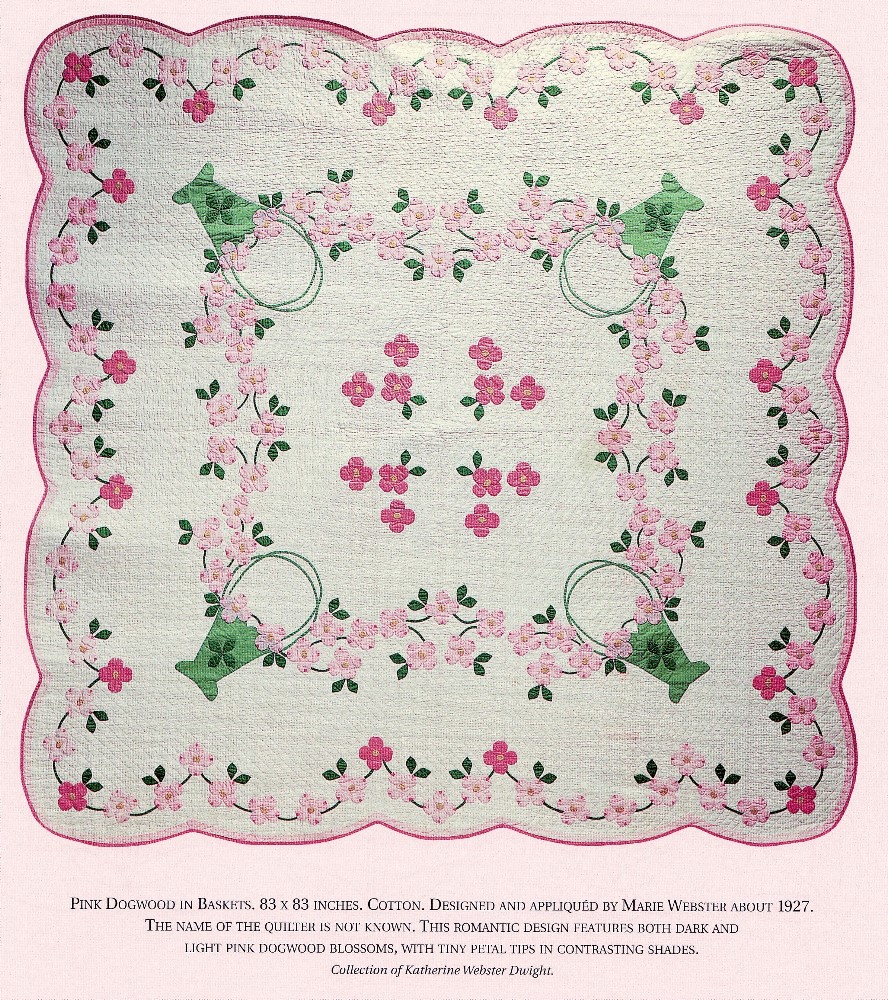
The Quilters Hall of Fame has one example of this quilt in its collection. Unfortunately, the maker and date of construction are unknown. The quiltmaker creatively added purple to the handles of the baskets. Hand quilting runs 9 – 10 inches per inch. The binding is pink and is echoed along the inner edge by a half-inch band of pale pink bias fabric. The fabrics appear quite faded and the binding is worn, but it is a lovely quilt nonetheless. Thanks go out to Shirley Nowakowski for the generous donation of this quilt.
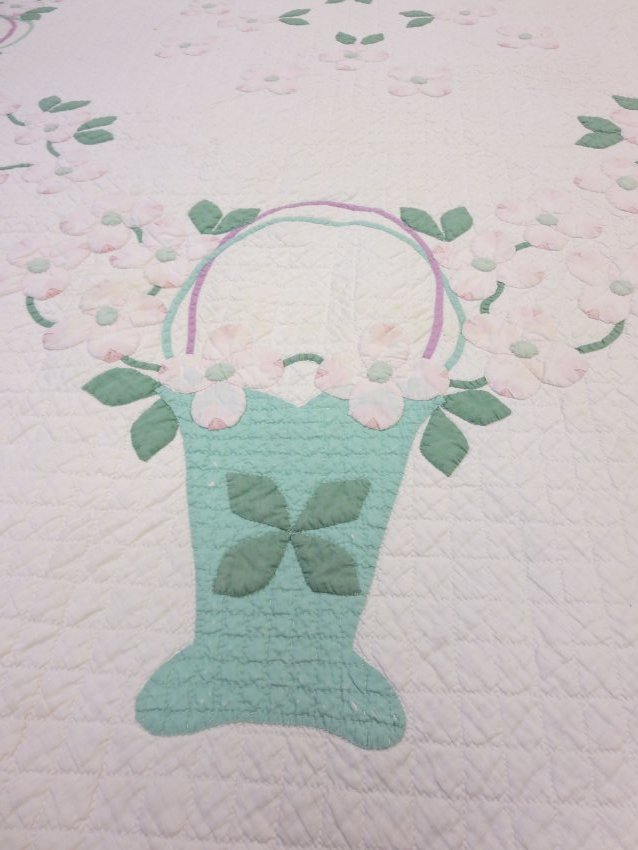
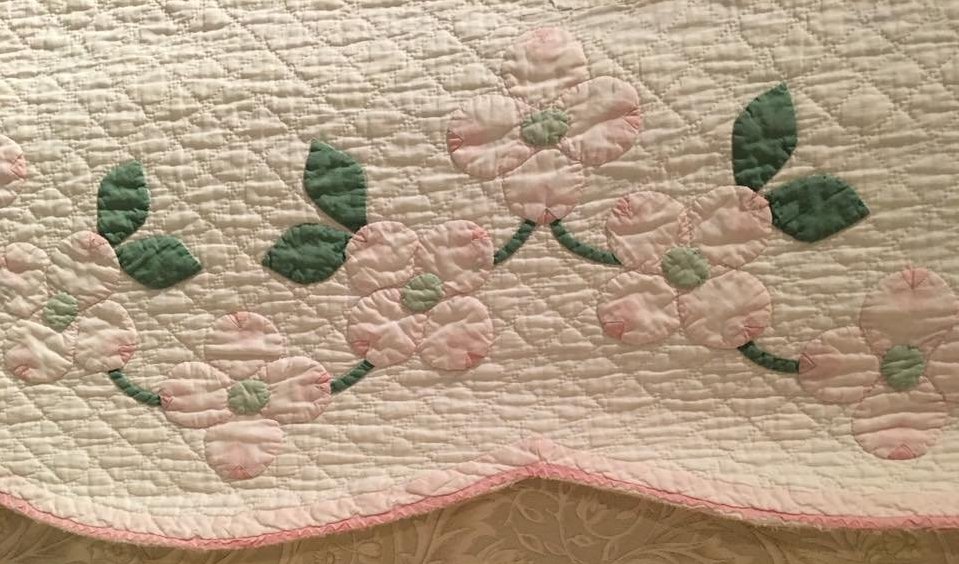
It is the mission of The Quilters Hall of Fame to honor our honorees for their contributions to the world of quilting. If you enjoyed this look into Marie Webster’s garden and Dogwood designs, please share this post with a friend.
Happy Quilting!
Deb Geyer
“Brown Doesn’t Go With Purple.” “Oh, Yes it Does!” Says Jinny Beyer
How’s this for a tee shirt or Facebook meme?
Everything I needed to know about color, I learned from Jinny Beyer.
It’s not quite accurate; I’ve known the color wheel most of my life, and as a dyer, I’ve read lots about color. But if there is one person in modern quilt history who is inextricably associated with color, it’s Hall of Fame Honoree Jinny Beyer.
Her quilting story began in India (read a full account here: https://quiltershalloffame.net/jinny-beyer/ ) where things were different from quilting in the States. At a time when dusty rose, dusty blue and seafoam green were the standard, Jinny worked in vibrant colors. Here’s her first quilt, made with Indian fabrics. It wasn’t going to fit in with the country look of the 1970s, but she worked with what she had—and achieved spectacular results.
If you read her Hall of Fame bio, you know that Jinny came home to the US and received lots of encouragement from Hall of Fame founder, Hazel Carter. (I love the inter-connectedness of the quilt world. And I especially love the theme of women helping women.) With Hazel and her guild cheering her on, Beyer jumped into competition. Here’s a photo of Jinny’s “Ray of Light” which won the Good Housekeeping and U.S. Historical Society contest, “The Great American Quilt”.
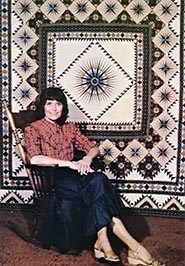
If you are up for a dip in the pool of hippie/ self-sufficiency culture (and some context for Jinny’s work), check out the full article at https://www.motherearthnews.com/nature-and-environment/jinny-beyer-master-quilter-zmaz81ndzraw Among other things, they describe Jinny’s paper folding technique for adjusting pattern size. There are better photos of the quilt on the internet, but I couldn’t resist the throwback. And if you want to see more quilts that Jinny has made, view the gallery on her website: https://jinnybeyer.com/quilt-gallery/ .
But let’s get back to the notion of color. This is a quilt that is currently for sale as a kit or pattern on the Jinny Beyer website.
Would you look at that? It’s brown and purple, and it works! What is this sorcery? It’s not dark magic, it’s Jinny’s color theory in operation. Using the method described in her book, Color Confidence for Quilters, you can put any colors together, as long as you make the proper transitions. And how do you do that? Well, to truly understand the process, you should read the book, but I can give you a very simplified visual using an object in the Hall of Fame Collection, a “Jinny Beyer Palette Poster”. (Warning label: I’m really leaving out a lot. The book is worth your time.)
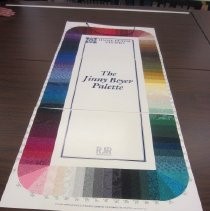
The poster shows 100 fabric swatches in the original fabric line that Jinny designed—all tone-on-tones or blenders. Start with a brown in the upper right, and go counter-clockwise around to the purples in the upper left. You’ll notice that this took you through some reds and oranges. And now go back to the quilt image, and you’ll find the same color range there.
This was heady stuff when it first came out (and still useful today). So much so that Wikipedia says, “Encyclopedia Britannica and RJR Fabrics credited her for being one of the first designers to form a fabric collection suited to the needs of quilters.” Of course, you can apply the Beyer method with other fabric, but it’s just too yummy to look at the palette pre-cuts she offers.
And now, here’s my quilt that I also called Marrakesh.
You’ll notice that I did not blend successfully (the green doesn’t fit—it’s in the inner border fabric, but I should have gone clockwise on the poster, from the reds through some yellows and golds to get to it) and I need to learn to miter. But I thought I was pretty creative when I ran out of outside border fabric and compensated with a stepped-in frame—kinda like a rug you would get at the market in Marrakesh.
So that’s my segue into another thing that Jinny Beyer has contributed to the quilting world: border fabrics. Talk about bang for your buck! Border fabrics do the work so you don’t have to. If you want an easy traditional quilt, you can alternate strips of the border fabric with columns of a simple block. All the design impact, and half of the piecing. It’s been on my “To Do” list; note the date in the selvedge.
Or, if you’re doing a round robin with friends, or otherwise going for the center medallion-style, border fabrics are your friends. (Timely for the AQSG 2021 Quilt Study which is “Framed Center/Medallion Quilts: History of a Style”.) Dare I say it? Border fabrics can really cut corners.
Or, if you’re truly ambitious, you can use border fabric as a design element, as in this quilt from one of Jinny’s many books.
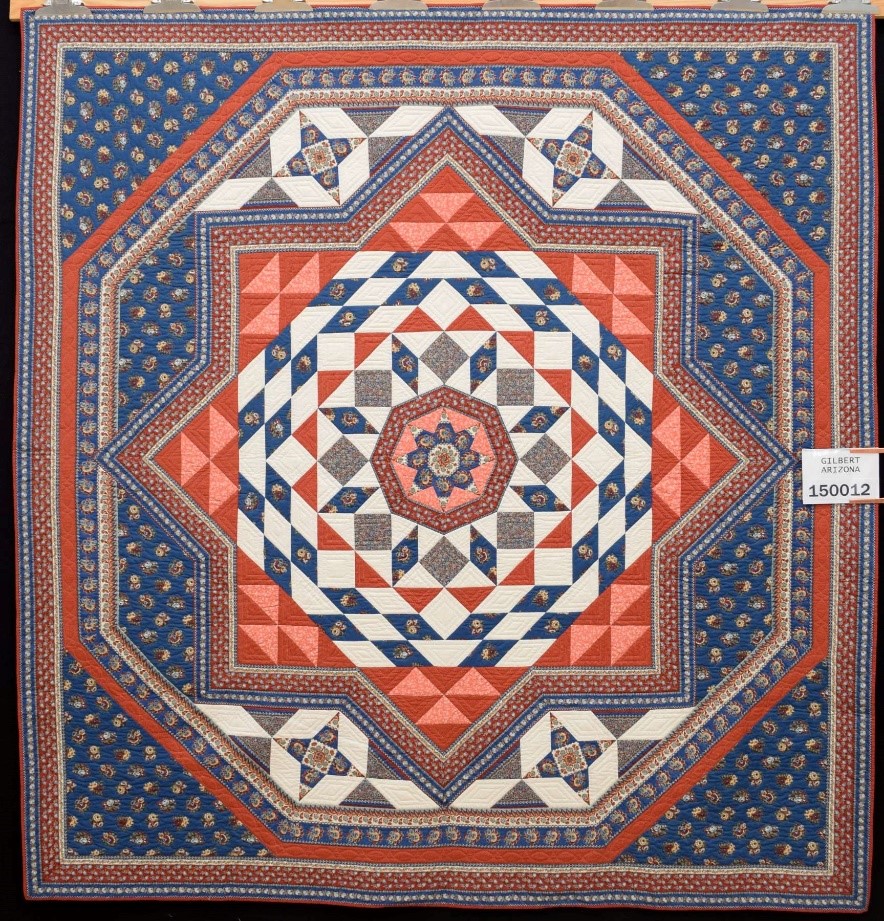
Or, sometimes, the border fabric inspires the colors of the field as in this original design using blocks from Jinny’s book ‘The Quilter’s Album of Blocks and Borders’.
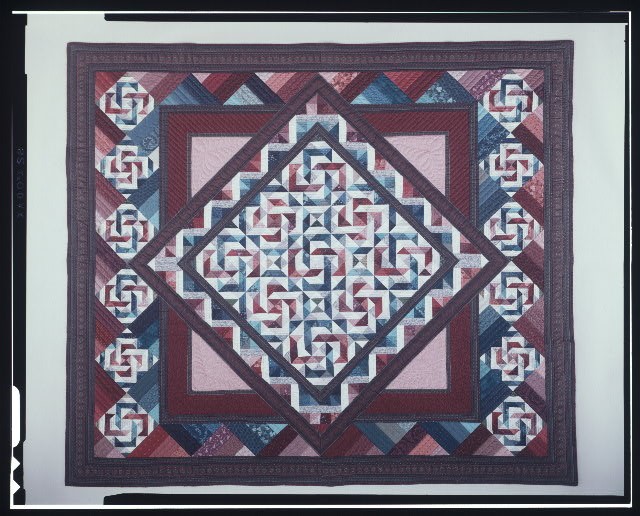
Here’s the Casablanca border from the Marrakesh quilt. (You’ll notice it’s really red, not brown. But it reads as brown in the photo above, so I took some poetic license to make my brown/purple point.) Next to it is a different print showing Jinny’s design genius. Many border prints on the market just repeat a single design, leaving you to figure out what part you want to lose in the cutting. But these all have a built-in seam allowance and two sizes, proportioned to the Golden Mean ratio to give you flexibility.
Although her designs are suitable for reflective piecing (think four patch posey or one block wonders), Jinny seems to use border fabric mostly as a frame for her quilts. I enjoyed reading about Jinny’s design decision-making on her blog at https://jinnybeyer.com/category/blog/borders . You can she how she works with color and decides which border best complements a quilt—a real step by step journey through the creative process.. There’s also lots of information about working with border fabrics here https://jinnybeyer.com/tips-and-lessons/working-with-border-print-fabrics/ .
There’s also lots of free stuff on the general site, including a pattern for table runners. Notice how the designs are perfectly matched, and compare mine using a non-Beyer border print.
I think I need to get the pattern and go shopping for some more Jinny Beyer fabric; this is going to be a costly blog, but all of Jinny color and opulence has made it worth it. Stay tuned to see if I actually sew something.
Your quilting friend,
Anna
If You Can’t Get Outside, Take a Page from Jean Wells
It’s a rainy day here and I wouldn’t be outside even without the stay-at-home order. So it’s a good day for a “visit” with Jean Wells.
Honoree Jean Wells Keenan has a birthday coming up on Saturday (May 23rd). Wish her a happy day on her Facebook page. You may know her as the founder of the Sisters Quilt Show in Oregon—more about that later—or as the author of nearly 30 quilt books. If you don’t know her and want a quick bio, read here: https://quiltershalloffame.net/jean-wells/.
Early in my quilting journey, I discovered two of her early books. I was fascinated by her use of color and her interpretation of nature. She could turn a simple quilt into mixed berry delight or a field of flowers. These three books, with photos by her daughter, Valori, transported me out of my quilting room and into a beautiful outside world.
Since you’re probably stuck inside, you may enjoy a little of the flavor of those books on Jean’s blog: https://stitchinpostinsisters.typepad.com/stitchin_post_in_sisters/jean-wells/ Or, here are two garden quilts made for one of the books.
Right: Made for a book written by Jean Wells. Ingham, Ruth Golden. String Pieced Flowers. c.1995. From Oregon Quilt Project, Oregon Quilt Project. Published in The Quilt Index, http://www.quiltindex.org/fulldisplay.php?kid=6A-FD-119. Accessed: 05/17/2020
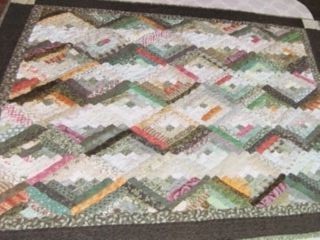
Here’s one of my first quilts, made after the Salad quilt in Through the Garden Gate. I was just starting with the idea of color, and was proud of myself for “planting” eggplant, corn and carrots in my straight furrows. Clearly, I didn’t capture Jean’s sensibilities, but at least I moved away from my usual early two- and three-color palette.
I called it “Mary, Mary, How Does Your Garden Grow?”, and gave it to my sister-in-law who is a Master Gardener.
But, enough about me.
Many of the quilts in her books are made by others, but Jean is also a prolific quilter herself. Here’s one where she got the color right and introduced the interesting technique of portrait applique, as explained on the Quilt Index:
“Applique Techniques-The quiltmaker used her originated technique called the “Portrait Method” where a smaller version of the larger quilt is constructed and backed (using a pillowcase edge finish) and then applied to the surface of the large quilt at specific locations. In this quilt, the “portraits” are applied with an invisible applique stitch through the backing fabric only, onto the large quilt, all around the portrait perimeter. This effect causes the quilt design to look as if it is floating above the surface of the quilt. This gives depth and dimension through light, shadow, and texture. “ Wells Keenan, Jean. Hidden Stone. c.2010. From Oregon Quilt Project, Oregon Quilt Project. Published in The Quilt Index, http://www.quiltindex.org/fulldisplay.php?kid=6A-FD-146. Accessed: 05/17/2020
I can’t imagine making the large version of this, let alone several minis to add on. But obviously, I’m not Jean Wells, nor was meant to be. Take the time to see more of Jean’s work at https://jeanwellsquilts.com/gallery.html
As you could see from her gallery, Jean currently seems to gravitate to “art” quilts, and here are several of her more recent books.
But she also wrote books for more traditional quilters, especially in her “Patchwork Quilts Made Easy “ series. Here’s a quilt she designed for her book “Buttonhole Stitch-Applique”.
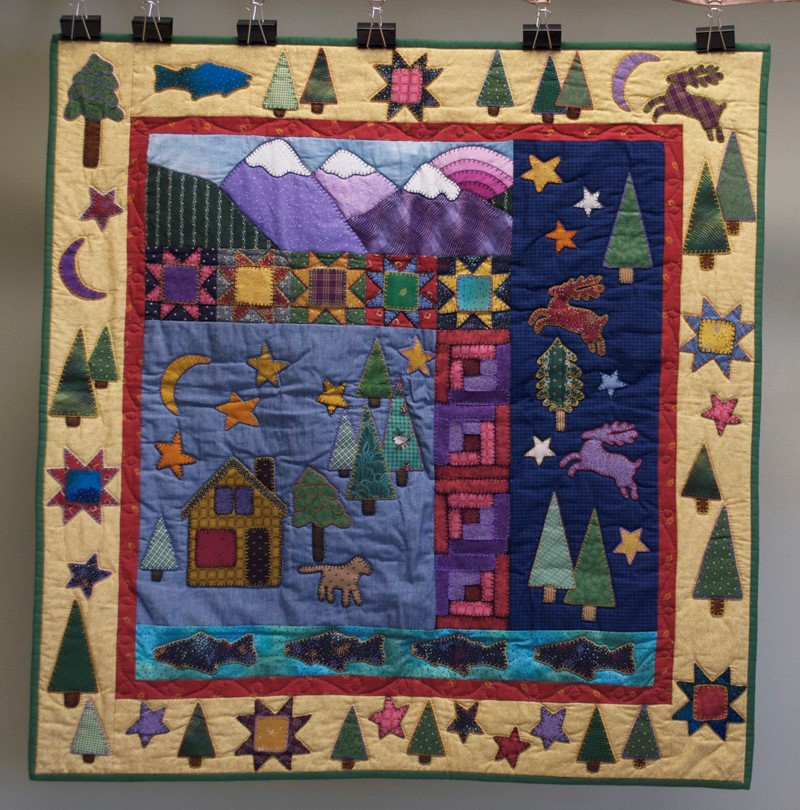
Wells Keenan, Jean. Pine Meadow. c.1995. From Oregon Quilt Project, Oregon Quilt Project. Published in The Quilt Index, http://www.quiltindex.org/fulldisplay.php?kid=6A-FD-152. Accessed: 05/17/2020
The mountains in that quilt give me a segue to the Sisters Outdoor Quilt Show founded by Wells in 1975. A few years ago it was reported that the show had grown to an average annual attendance of 12,500 with an estimated economic impact in the Sisters area of $1.7 million per year. For 45 years the event has blanketed the entire town with up to 1,400 quilts. It’s on my bucket list and you can see why from these photos:
Like so many things, the actual show is cancelled this year, but will be held as a virtual event.
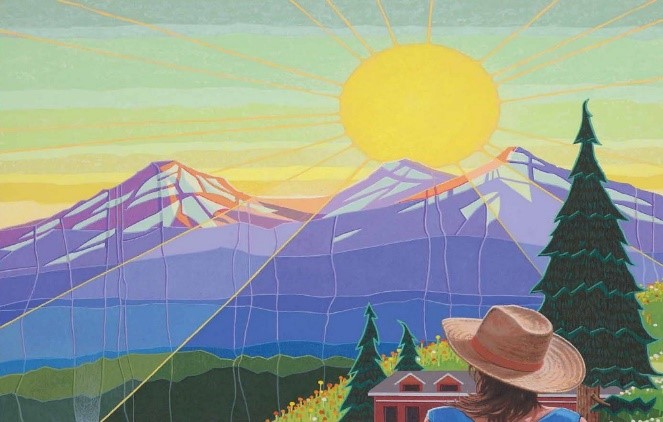
Press release at https://www.soqs.org/covid19
Over the years, Jean has taught hundreds, maybe thousands (not even including that first class of 9th grade boys). One of her techniques is taking a traditional block and getting her students to spark it up. Another is to use pure color (that’s where I went wrong) You can get a glimpse into Jean’s teaching technique by reading about one of her classes here http://karenquilt.blogspot.com/2012/06/jean-wells-keenan-comes-to-lopez.html. and here http://karenquilt.blogspot.com/2012/06/jean-wells-keenen-visits-lopez-ii.html. I want to sign up.
The Quilters Hall of Fame Collection has this article that starts with the New York Beauty block.

I’d be happy to be able to achieve either of those settings, but look what others have been inspired by Jean to create.
Right: “The blocks came from a B.O.M. at the Stitchin’ Post in 2011/2012” Vitek, Paige C. (Anderson). New York Beauty. c.2013. From Oregon Quilt Project, Oregon Quilt Project. Published in The Quilt Index, http://www.quiltindex.org/fulldisplay.php?kid=6A-FD-6FF. Accessed: 05/17/2020.
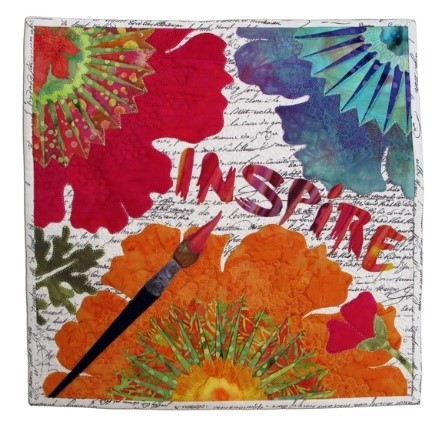
“I was inspired by Cynthia Mumford’s quilt “Cats in the Garden”. She made her quilt in 2007. In her Q.S.O.S. interview in 2011 she said she was inspired by Jean Wells’ quilt, “Paradise in the Garden” which was featured in the book “Garden Inspired Quilts” by Jean Wells and Valori Wells in 2002. I would love to know who inspired Jean Wells to make her quilt. “ Hoffman, JoAnn. Inspire. June 1, 2014. From Quilt Alliance, Inspired By. Published in The Quilt Index, http://www.quiltindex.org/fulldisplay.php?kid=1-6-30C. Accessed: 05/17/2020
I think I know who inspired Jean Wells: it’s always Mother Nature.
Your Quilting friend,
Anna
What’s it Like to Have a Career in Textiles? Ask Gail van der Hoof
I often think that, had I enjoyed a wider world view when I was young, I would have come to quilts much earlier than I did. As a 1950s child of the steel mill area of Chicago’s South Side, I knew no one who had quilts—it was chenille spreads for us . And I certainly had no idea that it was possible to study textiles or to get academic training as a museum curator. I wouldn’t say my youth was wasted (my English major gave me the life-long pleasures of reading and writing) but I look with a little envy at people like Honoree Gail van der Hoof whose lives took a very different direction.
Gail is known in the quilt world as the partner of another Honoree, Jonathan Holstein; in 1971 they co-curated a ground-breaking exhibit of quilts at the Whitney Museum of American Art. They are credited with changing the perspective of quilts as home goods/decorative arts into “real” art to be hung on walls. The 50th anniversary of that exhibit is coming up and I’ll write more about it later, but here are some images of quilts in the exhibit; they were collected by van der Hoof and Holstein and are all now at the International Quilt Museum in Lincoln, NE.
Center: Kaleidoscope
Right: Thousand Pyramids
For today though, I’d like to explore a more intimate aspect of this Honoree. First, take a few minutes to read the biography on the Hall of Fame website, and we can compare notes. https://quiltershalloffame.net/gail-van-der-hoof/
OK. Here’s one thing that struck a chord with me: Gail never became a quilter, but she had an over-arching interest in textiles. Imagine taking the Orient Express to Turkey to explore textiles! Can’t you see her in a market looking at rugs? I wonder if she haggled for her purchases? Probably so, if her introspective assessment gives us a clue. “I must have been a rag picker in my last life. I have always haunted thrift shops or used clothes markets and can always find something good.” How many of you can relate to that?
And that question opens the way for more questions. Do you love finding bargains? And what do you do with them? Are you like Gail and wear what you find, or are you shopping for fabric there? I know there are women who find old aprons and dresses to use for repair of vintage quilts, and I have read articles that suggest treasure hunting at the thrift shops for flannel shirts and hankies (for “masculine” and “feminine quilts”).
If you are a quilter, do you ever mix textiles, or do you stick with cotton? I tried using silk once and found it to ravel more than I expected—I probably should have used a stabilizer—but it catches the light in a way that makes the quilt more interesting. I’m going to have to “up” my technique if I ever get around to making a piece from my husband’s old neckties, and I have an idea for using some of my no-longer-worn scarves. But that’s about as far as I dare to go. The biography also mentions Gail’s other travels, to Holland, England, other parts of Europe, and to West Africa. All of those places have a significant and distinct textile history, and I wonder how much of that Gail explored on her trips? I’ve been to the Toile Museum in Jouy, France, and to the mills in Lowell, Massachusetts. I enjoyed seeing the swatch books of 19th century fabrics at the museum in Manchester, New Hampshire.
(There aren’t enough photos of Gail, so I’ve added my vacation pics.)
But all of that was just “spectator sport”. What would it have been like if I had studied textiles in college as Gail did? I don’t think I would have enjoyed it any more, but I certainly would have been better able to put it all in context.
So, I think that’s what makes Gail van der Hoof a Hall of Fame Honoree: the ability to have brought her academic training and work experience to see quilts from a different perspective. First, as something worth collecting, and then as something worth appreciating for art’s sake. She deserves her place and I’ll try not to be too envious of her career path.
Your quilting friend,
Anna
Need Inspiration? Channel Helen Kelley
How many of you were quilting while Helen Kelley’s column, “Loose Threads,” appeared in Quilters Newsletter magazine? I always felt like I was visiting with a good neighbor when I read her musings, and apparently many others did too because she successfully marketed three separate book collections of her articles. But after reading her Honoree bio on the Hall of Fame website, I found that I really didn’t know much about Helen after all. Click here and see if you learn something new too. https://quiltershalloffame.net/helen-kelley/
What’s interesting me about Helen Kelley right now, aside from the fact that I missed her birthday last month (I’m going to try to keep up and write about Honorees when their day comes up), is where she got her quilt ideas from, and the lengths she went to in exploring those ideas.
My first volunteer assignment at the Hall of Fame was cataloging books in the Library, and I was overwhelmed with Kelley’s donation of 600+ volumes. Thankfully, she had sent them to us with her own digital record system and all we had to do was convert to our Past Perfect format; but it was still a lot of work. Among the usual history and how-to books, Helen gave us so many books on Native American culture that we needed to create a whole new category for them. Some of these books must have been the source for her own book, Scarlet Ribbons, in which she explored Native American Indians’ use of French silk ribbon for reverse applique floral designs. And here’s just one of her quilts in a Native American style:
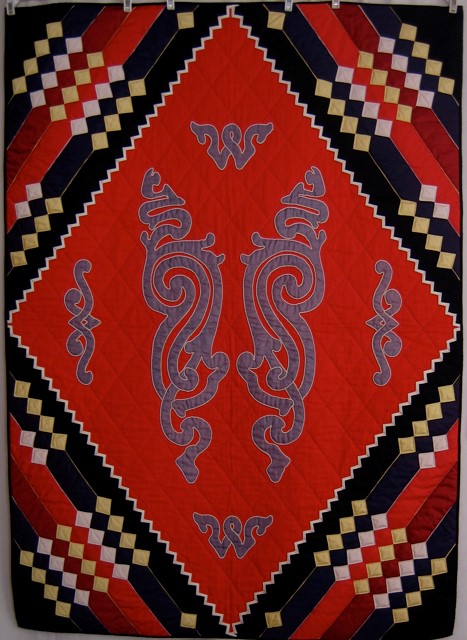
Kelley didn’t limit herself to North American ethnic groups when she looked for ideas; her vision was world-wide. In 1980, when quilt historian Cuesta Benberry started lecturing on African quilts, Kelley was able to encourage her and share with her a picture from her archives of an African quilt made for Peace Corps workers. So that’s one place she got her ideas: world heritage images. And her Norwegian heritage figured prominently too, as seen in this rosemaling design (with a couple of elves because it was for a grandchild).
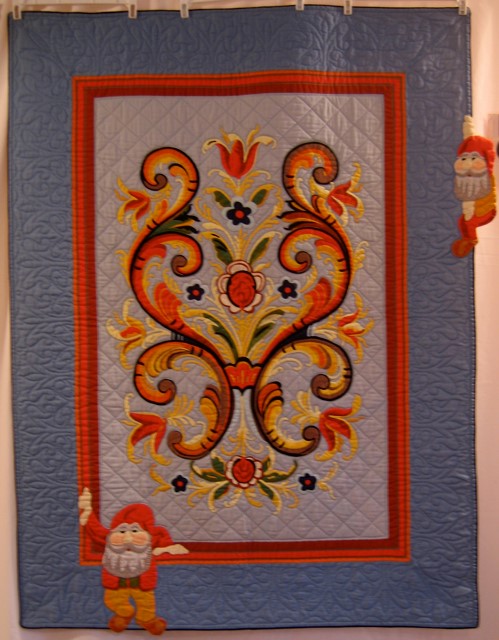
If anyone is interested in a research project, you could follow Helen Kelley around the globe and see how she extracted ethnic designs for her own quilting.
Another source of ideas was her actual travel experiences. She created twenty-four “postcard” quilts based on places she visited. Here are a few from the Hall of Fame Collection:
Center: San Fransisco (you know where)
Right: Stamp of the back of France
You can read a detailed description of each of these quilts, and see more photos at the following three links. And if you want to go farther down the rabbit hole, use the fourth link.
https://quiltershalloffame.pastperfectonline.com/webobject/FB7E22A5-500E-4A0B-9B2A-138487097847
https://quiltershalloffame.pastperfectonline.com/webobject/83265459-6B29-4B2B-BB2A-883216802964
https://quiltershalloffame.pastperfectonline.com/webobject/66CD395F-E987-4637-97AE-116182273970
https://quiltershalloffame.pastperfectonline.com/webobject/8590D7AF-F0E2-4606-BCA8-564523183646
If you checked that last link (welcome back), you may have also noticed another source of Helen Kelley’s ideas for inspiration: Just Do It. Her wall hanging with eleven suns was made to display different quilting techniques. So, if you want to showcase your skills, or try out some different sewing skills, follow a time-honored idea and produce a sampler.
Maybe you’re a history buff or enjoyed watching the Victoria series on Masterpiece Theater. If you were Helen Kelley, you’d turn that into a quilt idea. I love the was she incorporated the crazy quilt style that’s associated with the late Victorian Era.
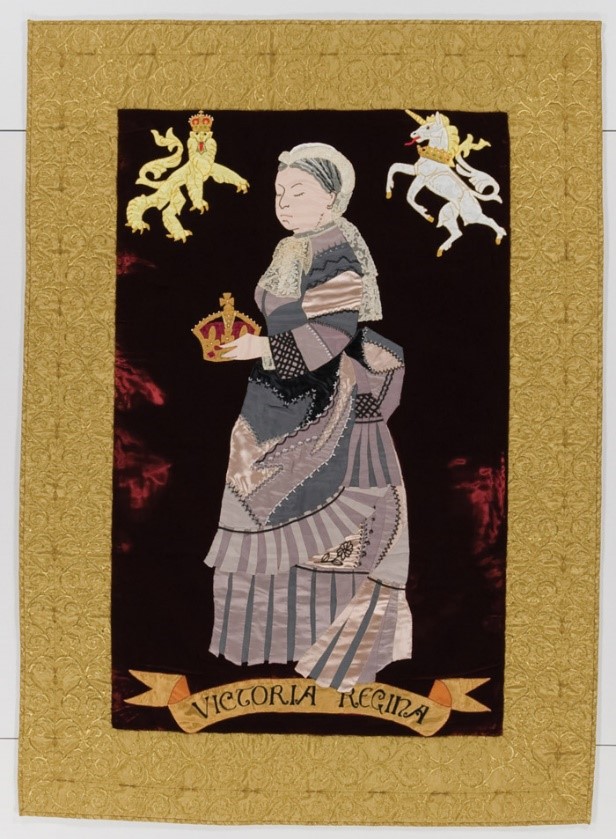
Of course, Kelley’s ideas weren’t all sophisticated or research-backed. Here’s a charming quilt she made for a grandchild. But even with this prosaic content, note the Anne Orr pixelated style. And I’m curious about/ impressed with the outer border. Was the idea to experiment with a technique as she did with the eleven suns, or was this crenelation supposed to be part of the fairy-tale setting?
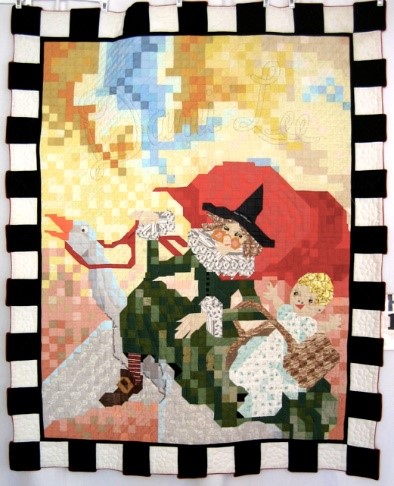
There are Helen Kelley quilts in which the ideas came from everyday life: a ring of children dancing around a tree on Stinson Avenue where she lived, the carousel at the State Fair, a farm boy with a toy tractor watching the real thing working in the field outside his window. And there are Helen Kelley quilts in which the ideas came from textiles of the past: traditional blocks in unusual settings or the Cluny Tapestry series (yes, one of the books items I catalogued was about the Bayeux Tapestry, but I haven’t found that on a Kelley quilt yet). And there is Helen’s quilt, Renaissance which was selected as one of the 100 Best Quilts of the 20th Century. It was based on traditional Norwegian tapestry and made in honor of her husband’s grandmother.
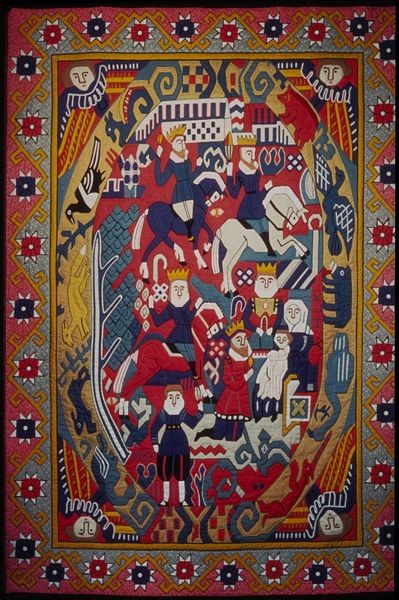
Where do your quilt ideas come from? I generally just find a pattern and some fabric I like, but after researching for this post, I wonder if I couldn’t stretch myself. Helen Kelley had no shortage of sources for her quilt designs. Whatever was part of her world or part of the whole world was fair game. If you find yourself not knowing where to go with your next quilt, take a hint from Helen, look around you with new eyes, look to a different culture, look into the past. Stay tuned; I might try that myself.
Your quilting friend,
Anna
Anne Ore Asks, “What’s it Worth to You?”
You wouldn’t think that Honoree Anne Orr could spark a controversy, but I bet I can put a spin on her that will start a debate—or at least get you thinking about your own work. But before I stir up trouble, let me give you the basics about this Honoree.
If Anne Champe Orr were around today, we’d probably call her a Steel Magnolia.
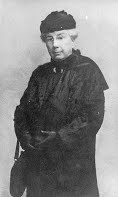
She was born (on April 17th, so it’s her birthday month) to a wealthy family in Nashville Tennessee, married into society, and had debutante daughters, but she wasn’t just decoration. Early in her adult life, she branched out from charitable and civic fundraising into the world of publications. As editor of Southern Woman’s Magazine, she wrote about antique collecting and needlework and launched a successful national business in patterning crocheted, tatted, and other hand-worked household items. From 1921 to 1940, she was the needlework editor for Good Housekeeping magazine, and her legacy continues with the re-publication of several of her pattern books by Dover Publications (available on Amazon, Etsy, and probably your local library). Click this link to read more about Anne Orr’s career. https://quiltershalloffame.net/anne-orr/ And if you are interested in a scholarly approach to Orr’s business acumen and marketing style, read Merikay Waldvogel’s article here: http://www.quiltindex.org/journals/article.php?Akid=2-B-AC
Orr didn’t come onto the quilt scene in a big way until the late 1920s. Her Good Housekeeping position opened opportunities for her to judge several quilt contests, including the Sears contest at the Chicago 1933 World’s Fair and the Macy’s contest at the New York Fair in 1939. Orr designed a number of quilts, and although they account for only about one sixth of her output, to me her most recognizable style is a pixel rendering of floral images, like these:
Right: Clarke, Laura May. Rose Wreath. 1937. From Michigan State University Museum Collection. Published in The Quilt Index, http://www.quiltindex.org/fulldisplay.php?kid=1E-3D-14. Accessed 04/25/2020
The Quilters Hall of Fame is fortunate to have two Anne Orr examples in our online Collection, a top and a quilt, that you can see here: https://quiltershalloffame.pastperfectonline.com/webobject/2E836B07-A0B8-4C2E-B9DC-498084127380 and https://quiltershalloffame.pastperfectonline.com/webobject/A83E4C36-5146-436F-9C63-650966340421
But, she also designed applique patterns (called patchwork at the time) and you can see two examples in the Quilters Hall of Fame Collections at https://quiltershalloffame.pastperfectonline.com/webobject/D6AC2529-8E61-441C-97EB-863611094727 and at https://quiltershalloffame.pastperfectonline.com/webobject/5DF211E6-5841-4F75-9AE7-651910503210
Well, did the history and eye candy lull you into forgetting that I promised controversy? How could this sweet old lady/ successful business woman fan any flames? It’s because of the quote on the Hall of Fame site, “Do your best in workmanship, design, and careful selection of color, so that the finished article will justify any work and be an heirloom to hand down for generations”.
“Justify”? Wait just a minute, quilting is supposed to be a hobby! I generally try to do my best, but I’m from the galloping horse school and I subscribe to the idea that perfection is the enemy of production. I know there is precision sewing going on elsewhere, and I admire it, but it’s not worth it to me to insist on achieving it myself. Maybe it’s because I don’t have children and I know that my quilts won’t be passed down the generations. Maybe it’s because I don’t feel like I’m making art; I’m just having fun.
So, do others share my perspective? Or are you someone whose points are never cut off and who will re-sew a seam as many times as it takes to get it right? Would Anne Orr judge your work and find that you have made good use of your time and talent? I’d be interested in hearing both sides.
In the meantime, April 28th is the birthday of another Honoree, Helen Kelley. I’ll write about her next.
Your quilting friend,
Anna
Tuesdays aren’t just for tacos
I started writing this weekly blog to coincide with National Quilting Day, which was a Saturday. But that timing doesn’t work for me very well, so we’re switching my posts to Tuesdays. You would think that with the stay at home order, one day would be just the same as the next. Well, it isn’t. I guess I have too much in-grained sense of school days/ work week, and unlike the Dowager Duchess on Downton Abbey, I do know what a weekend is. So, please check back on Tuesdays; it’ll be TQHF Tuesday instead of Taco Tuesday.
Your quilting friend,
Anna




